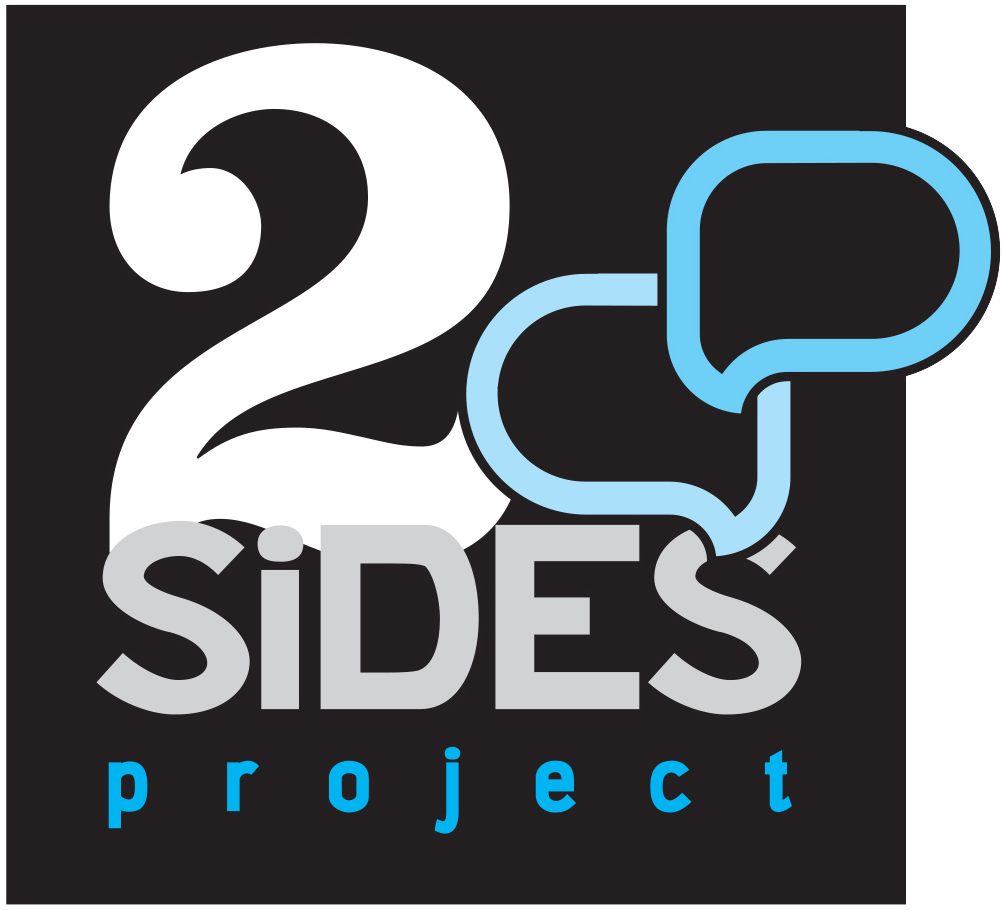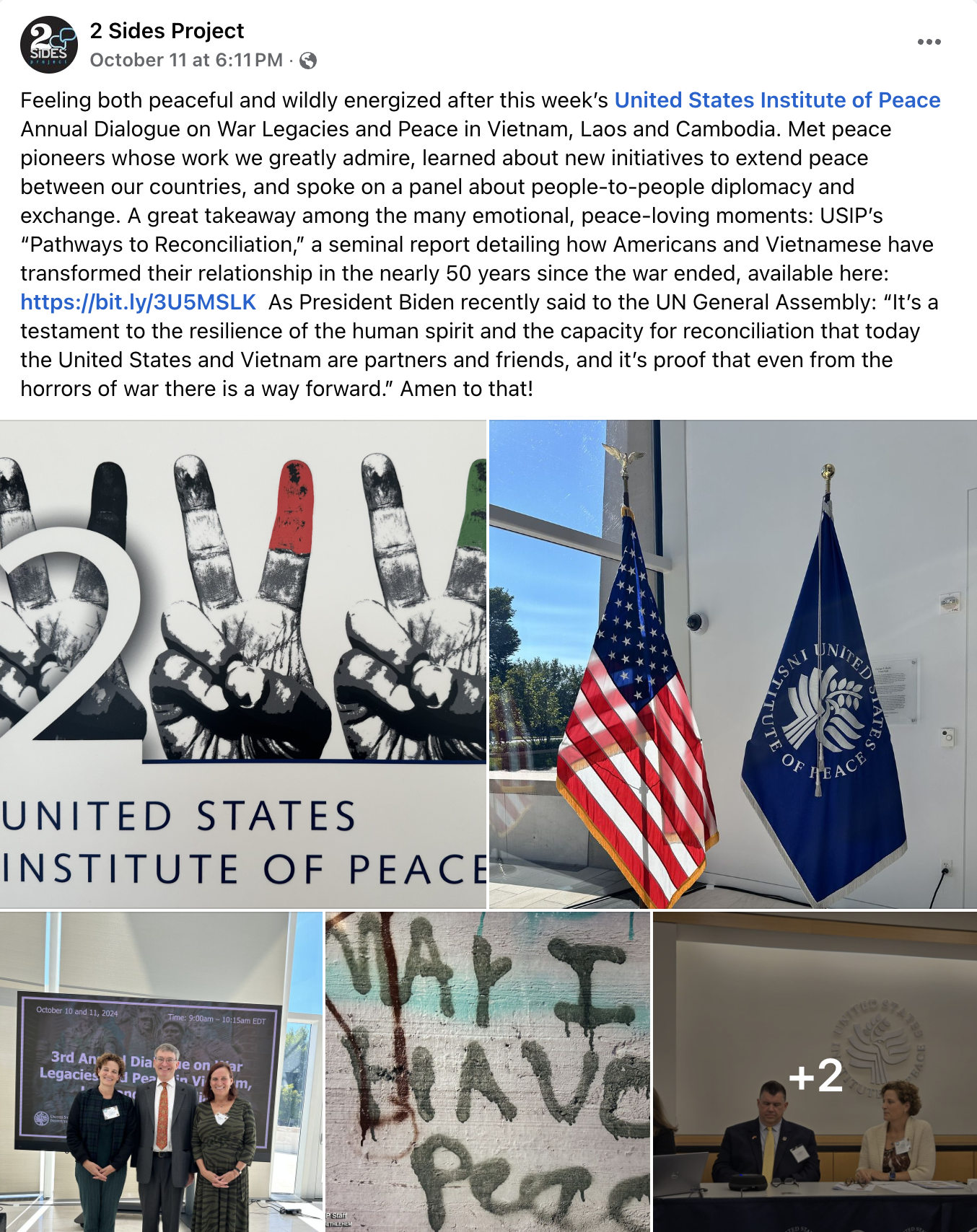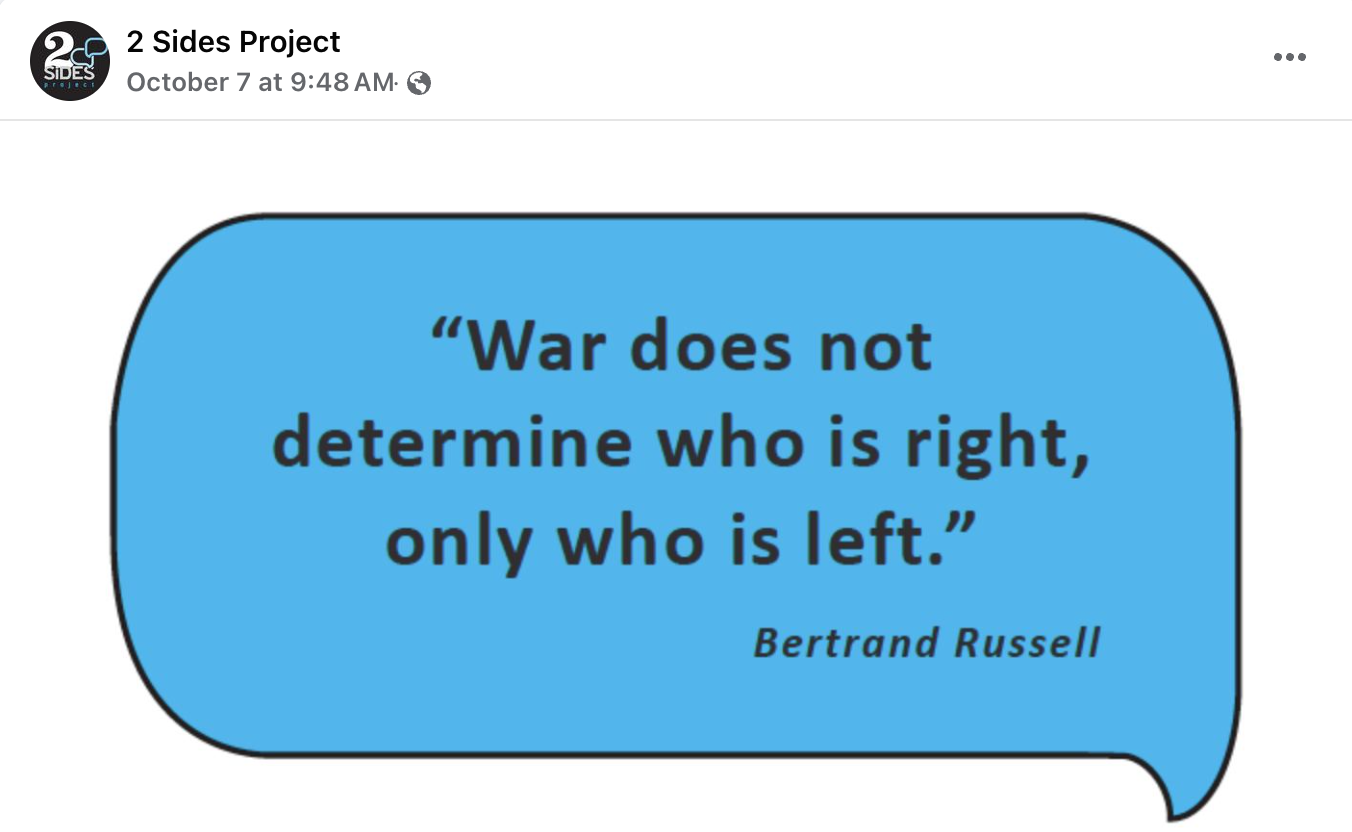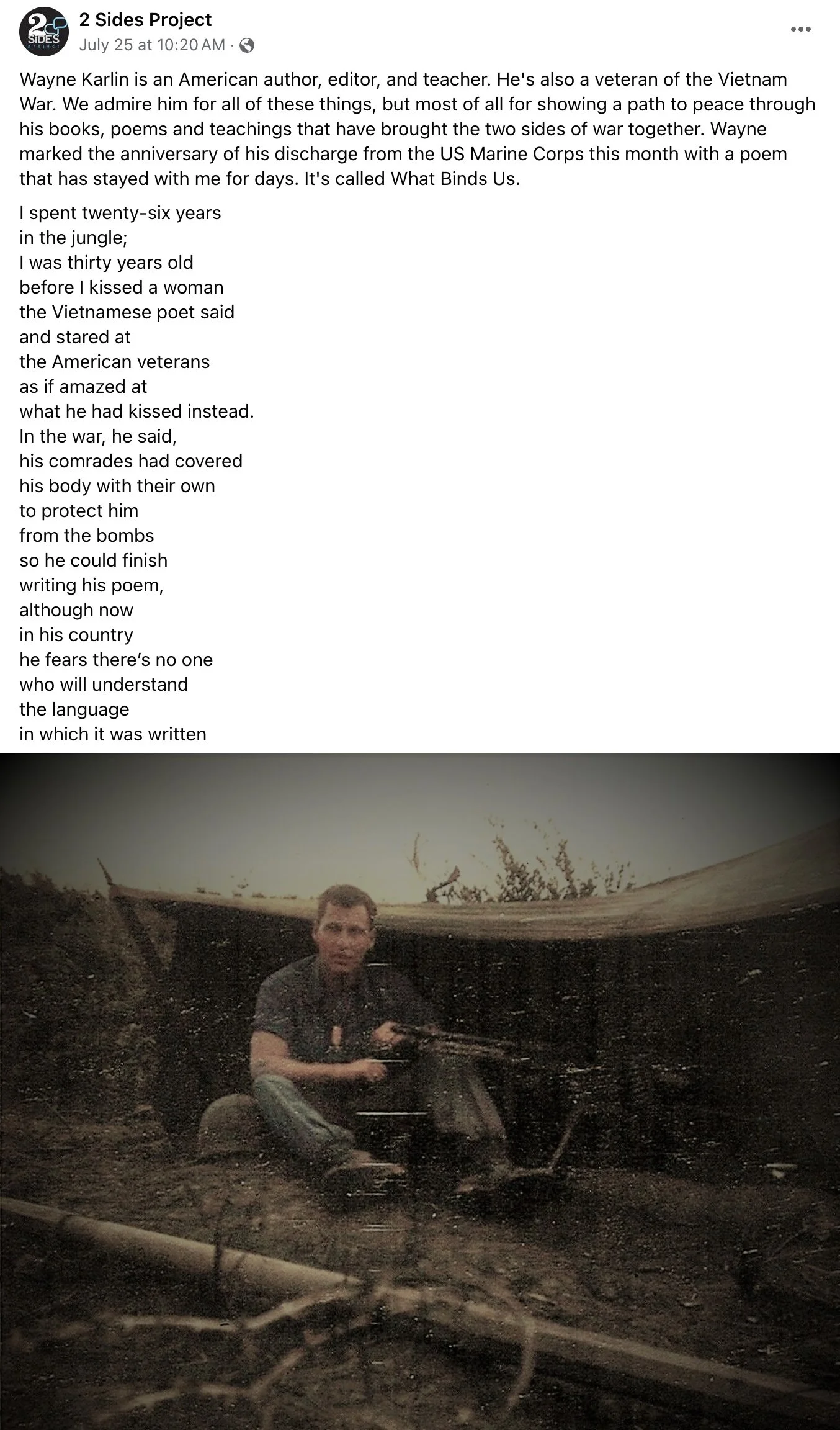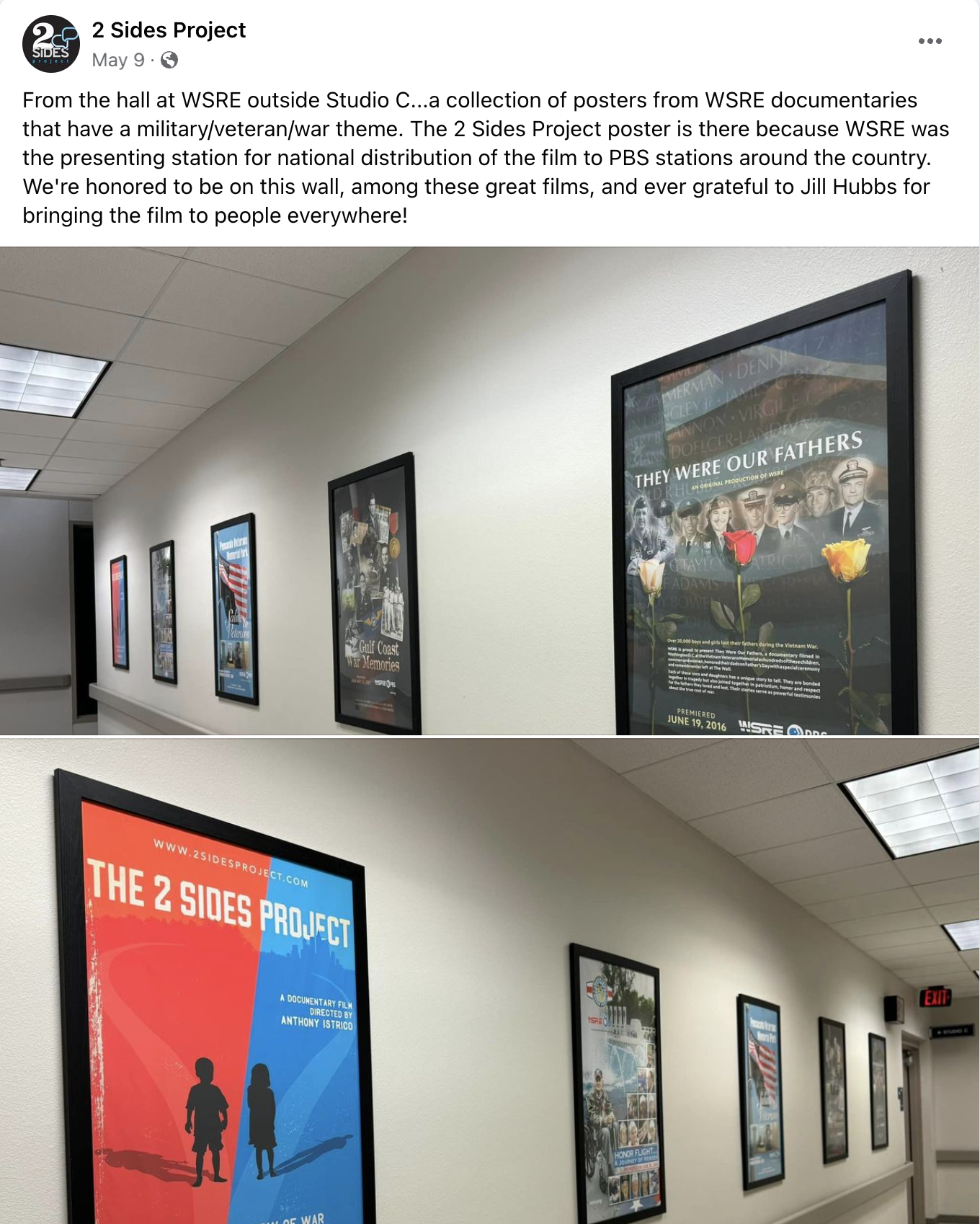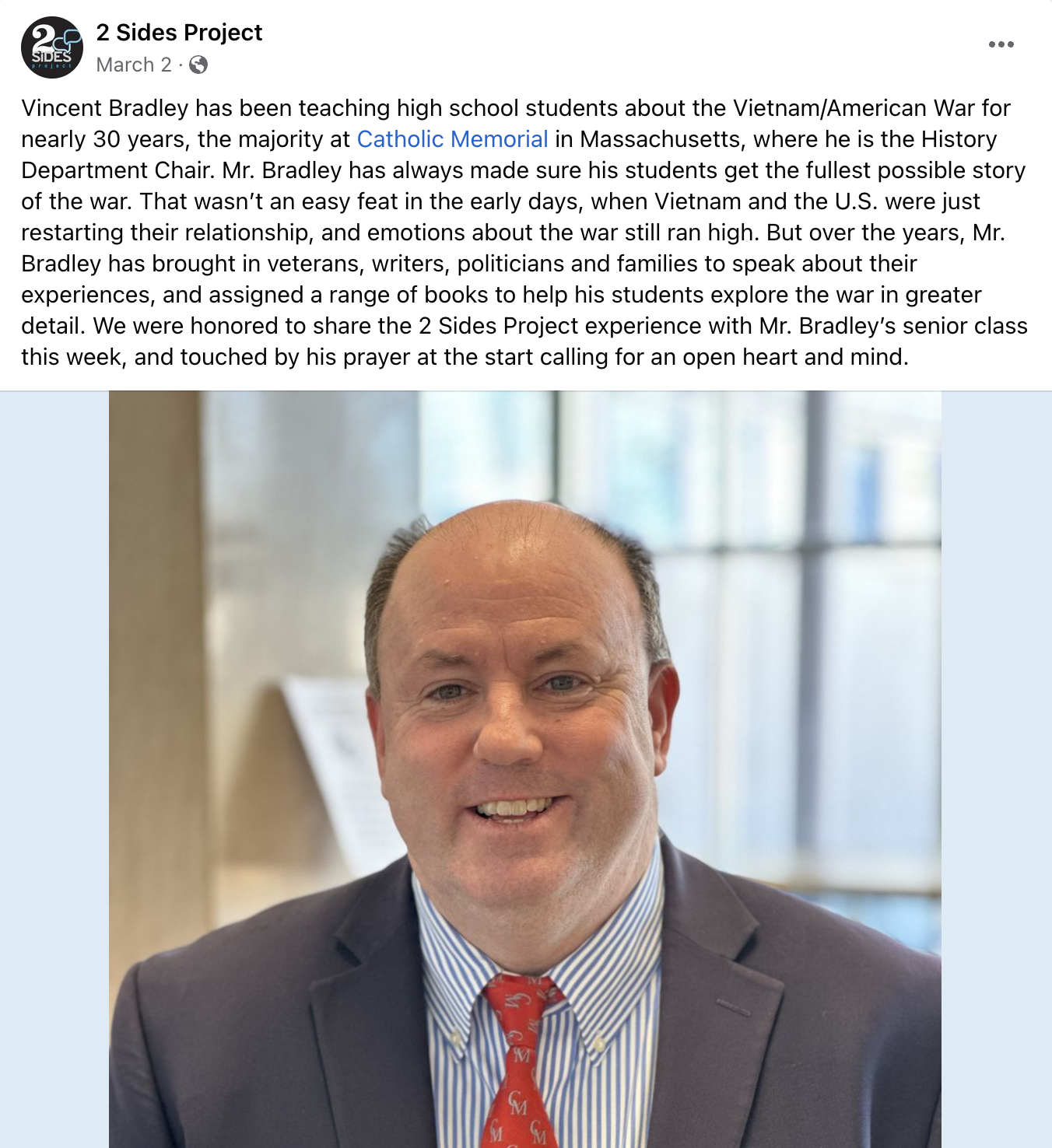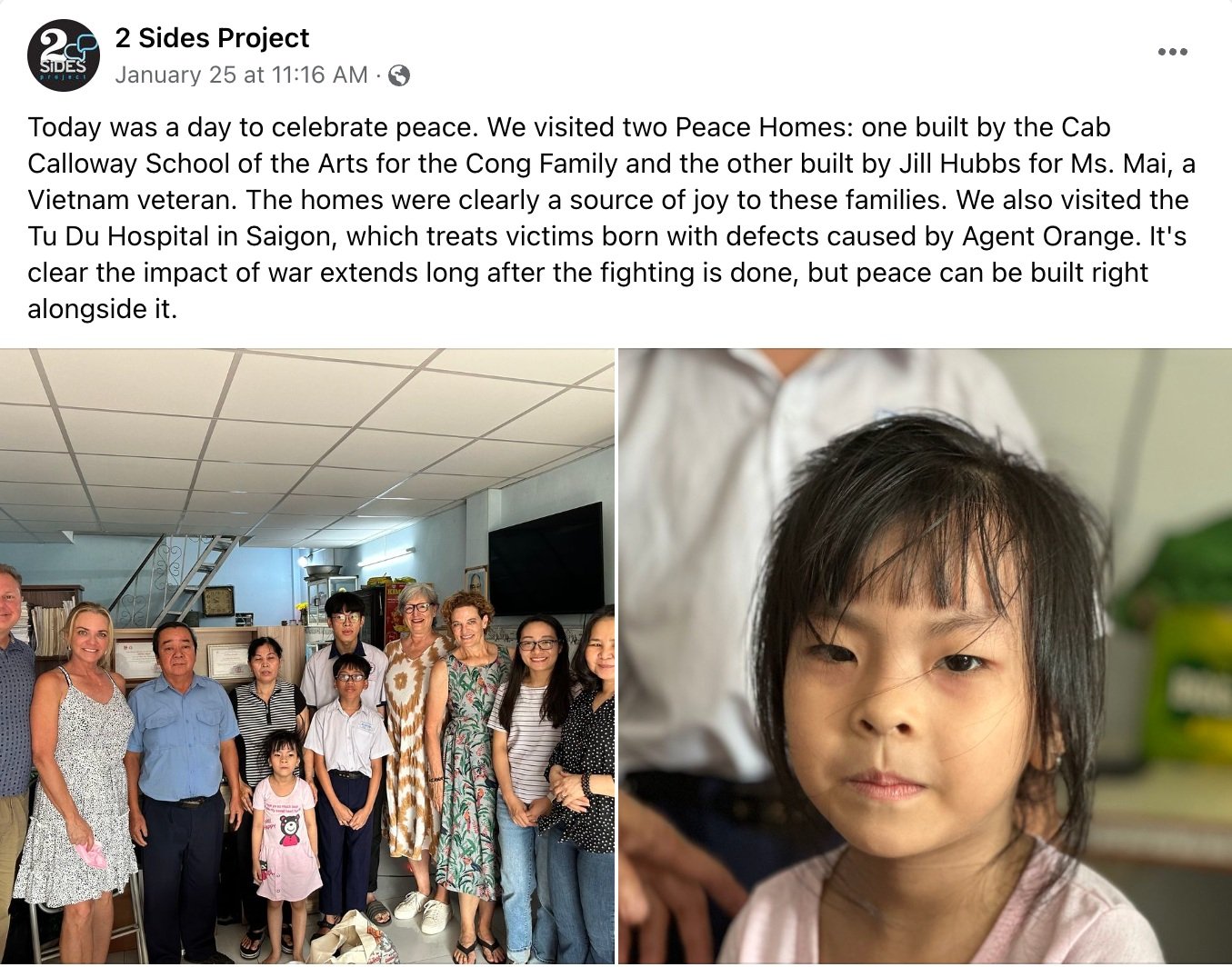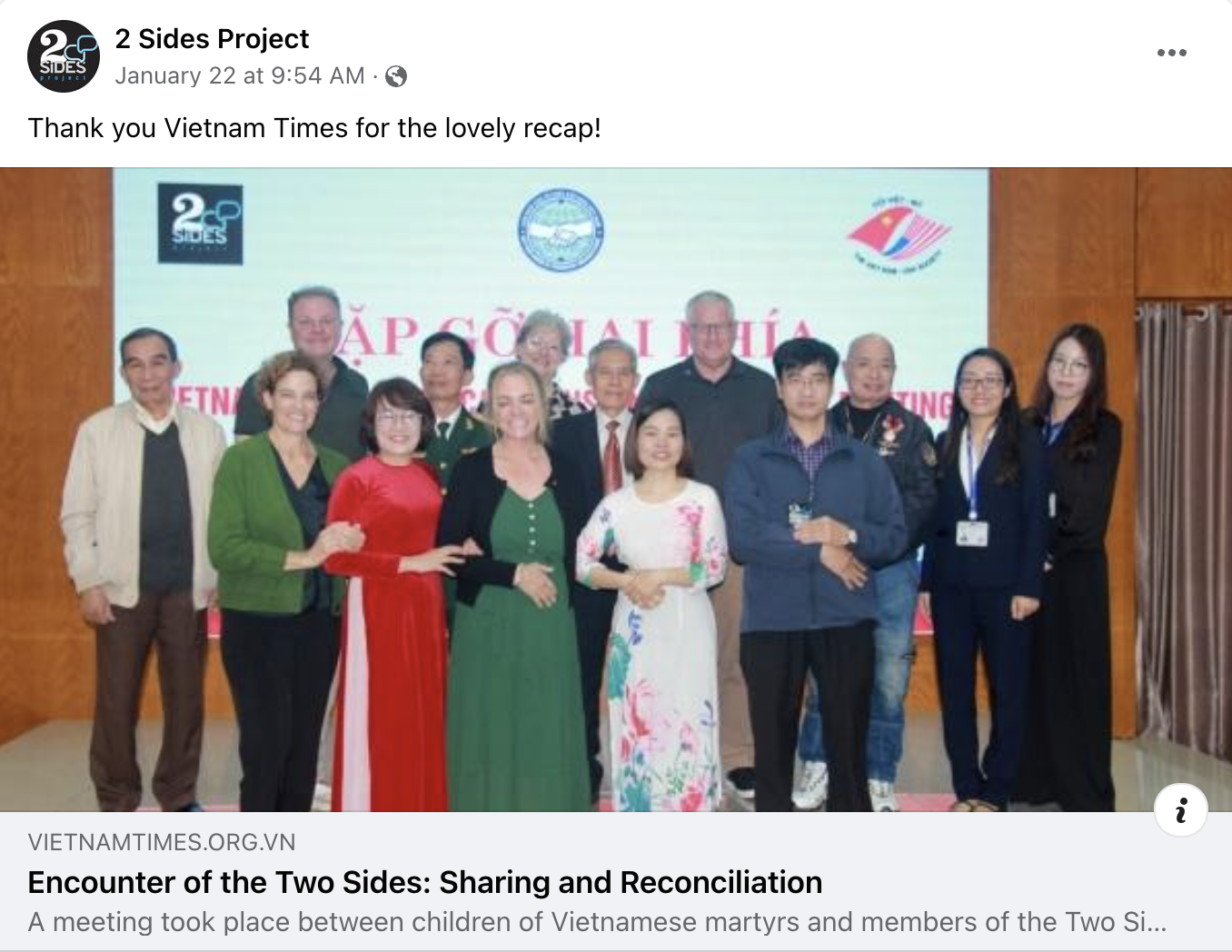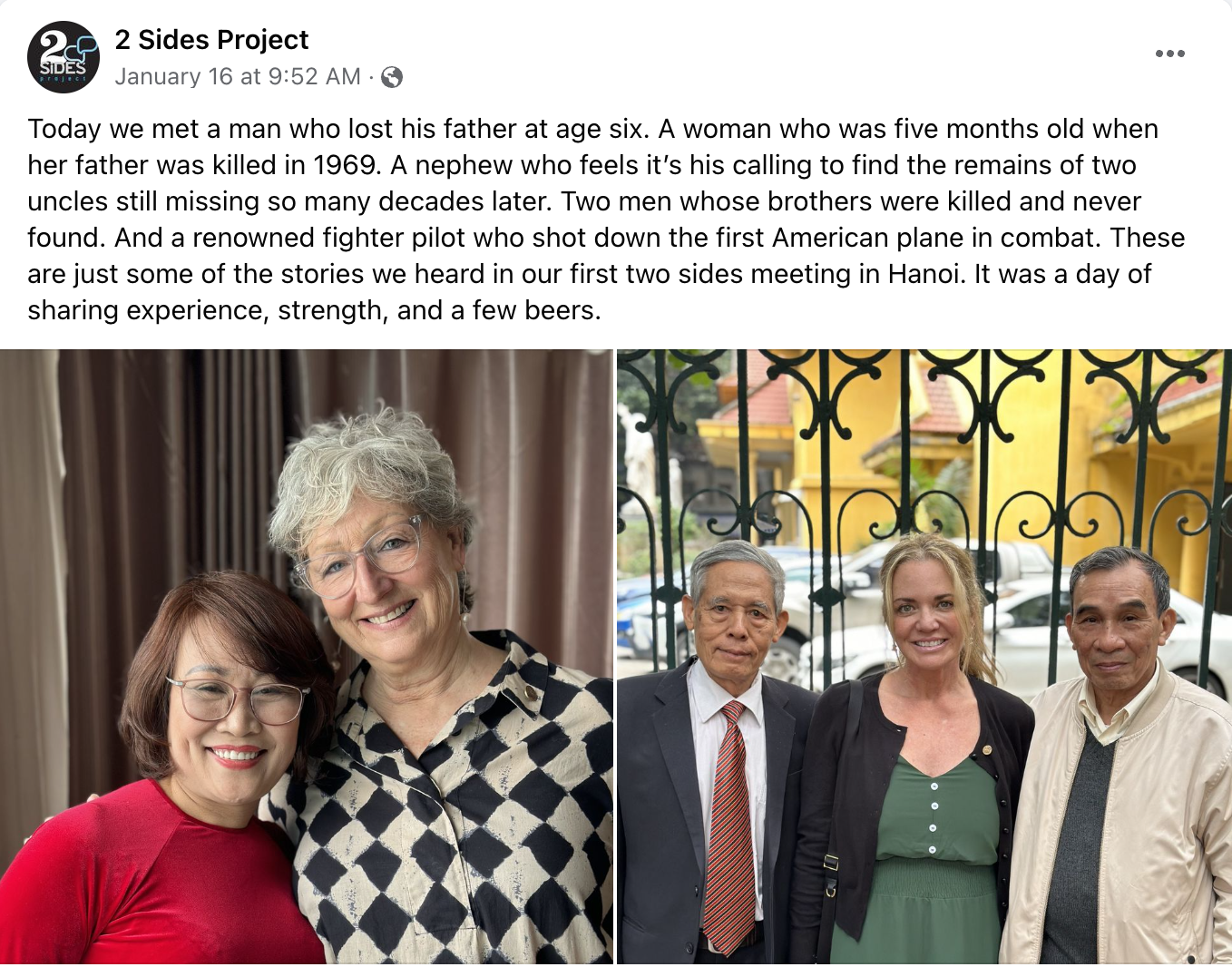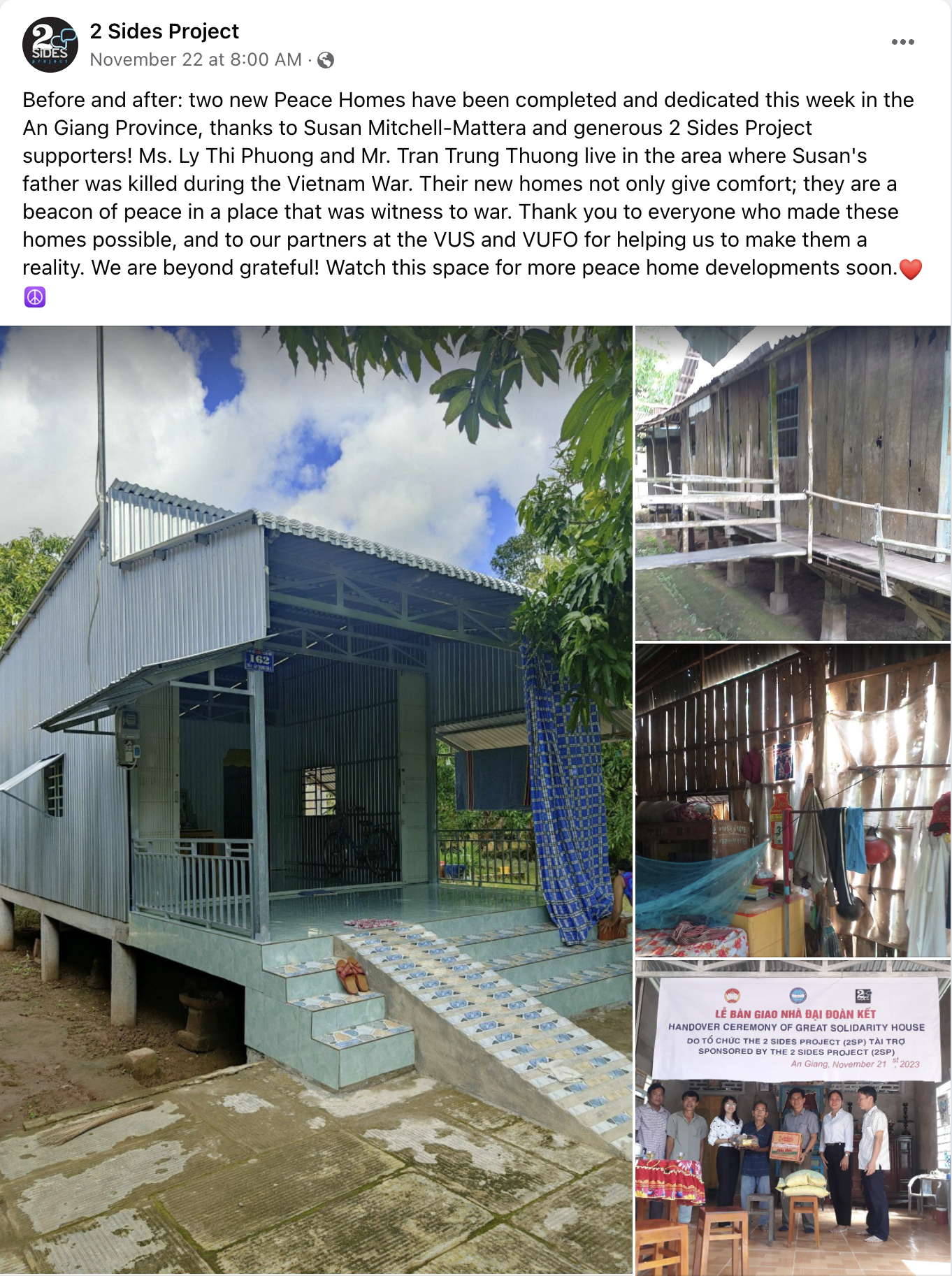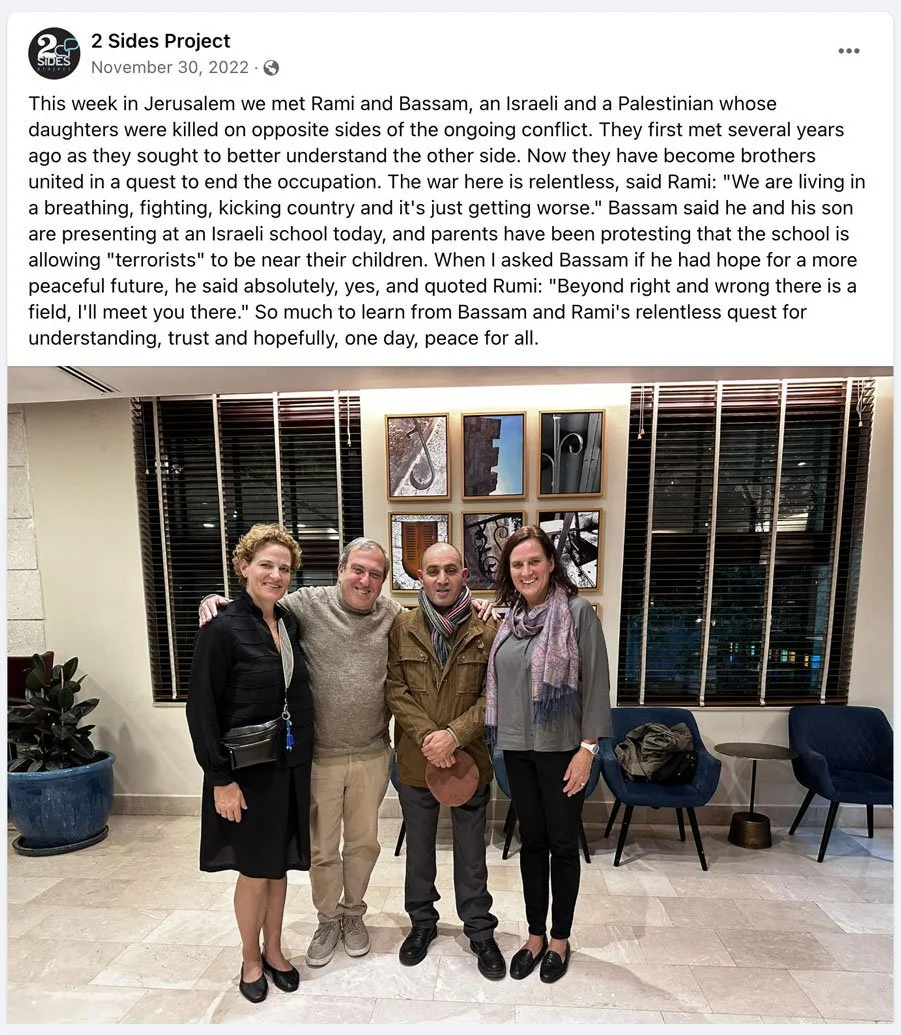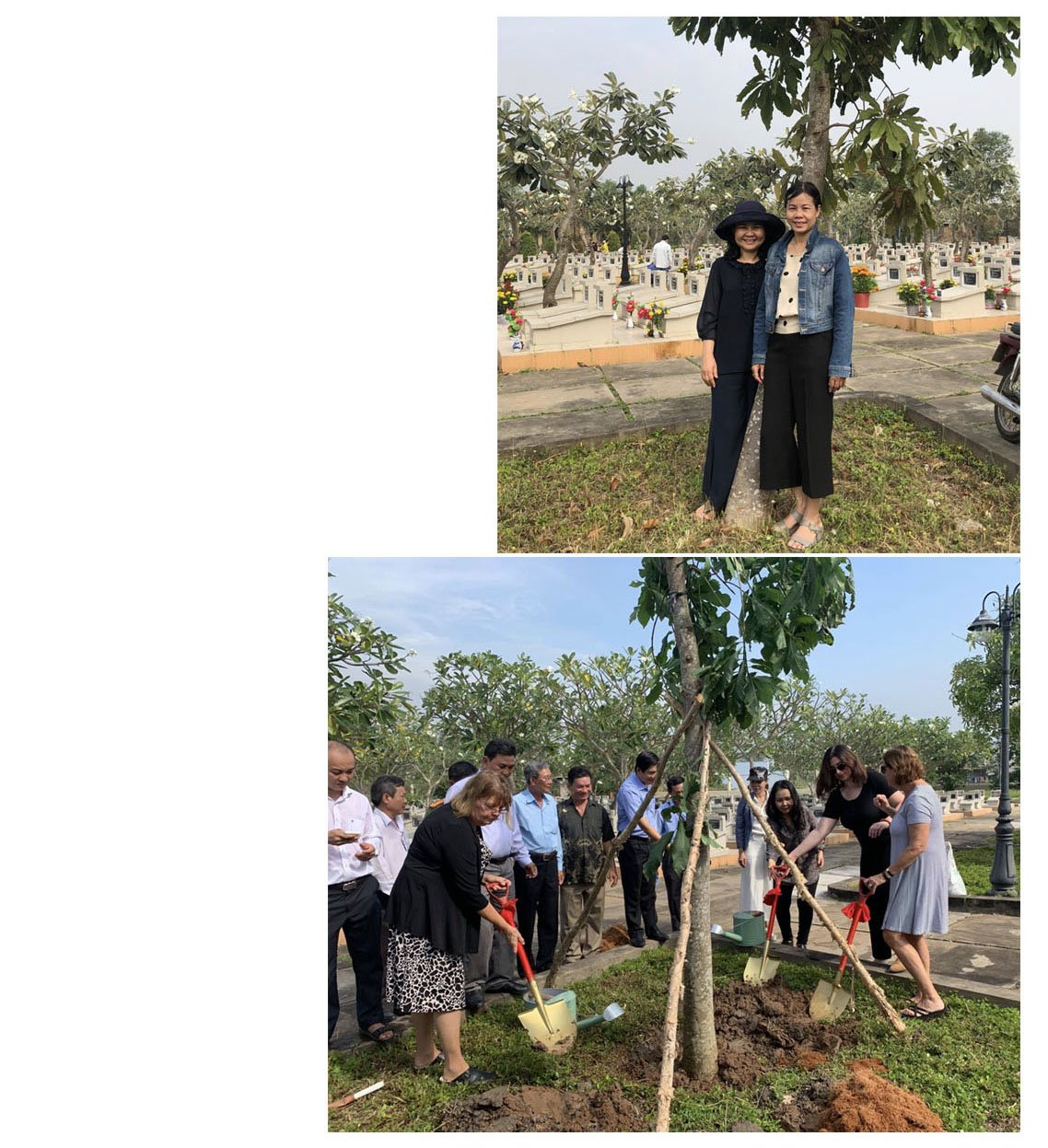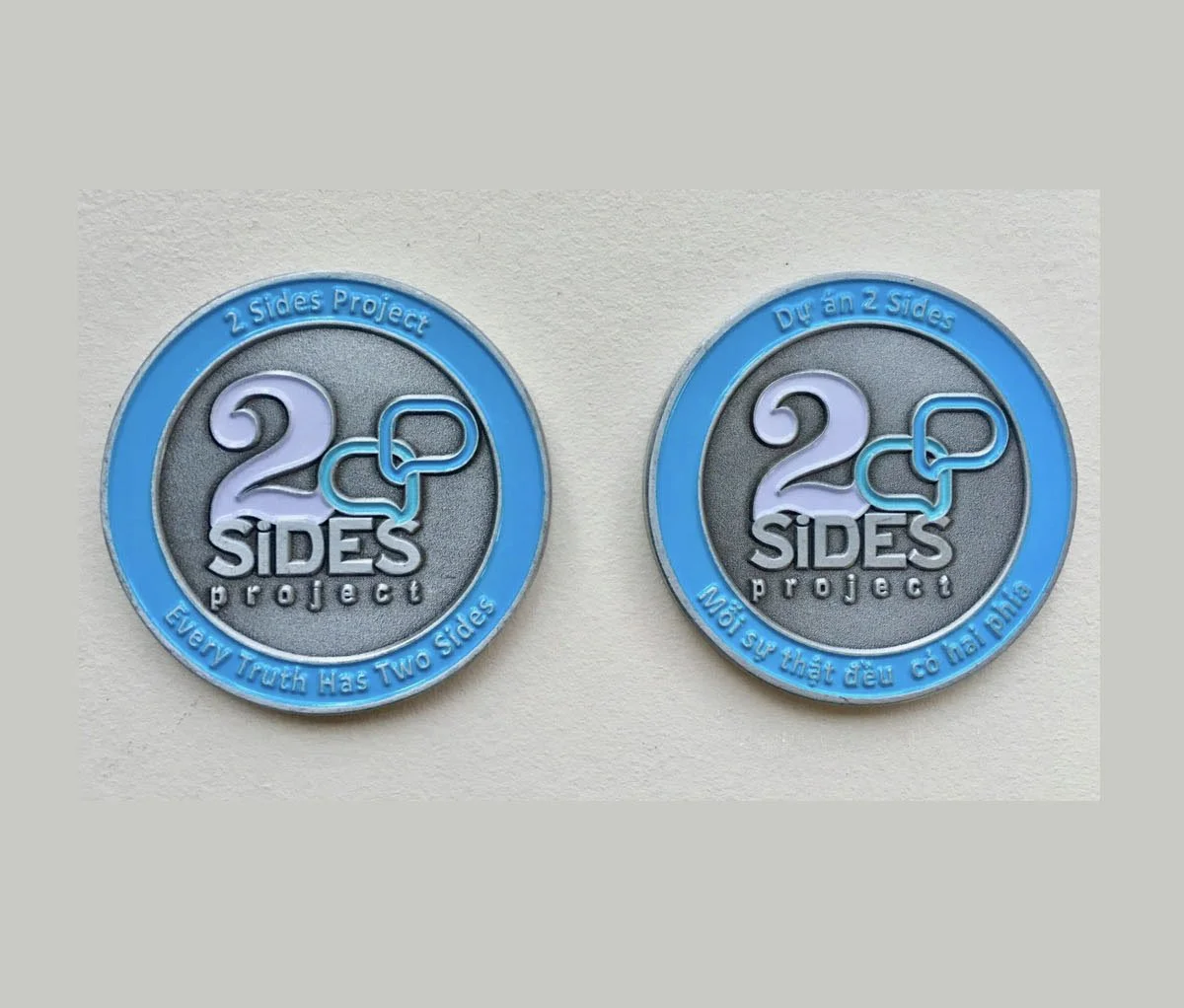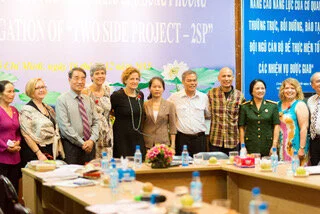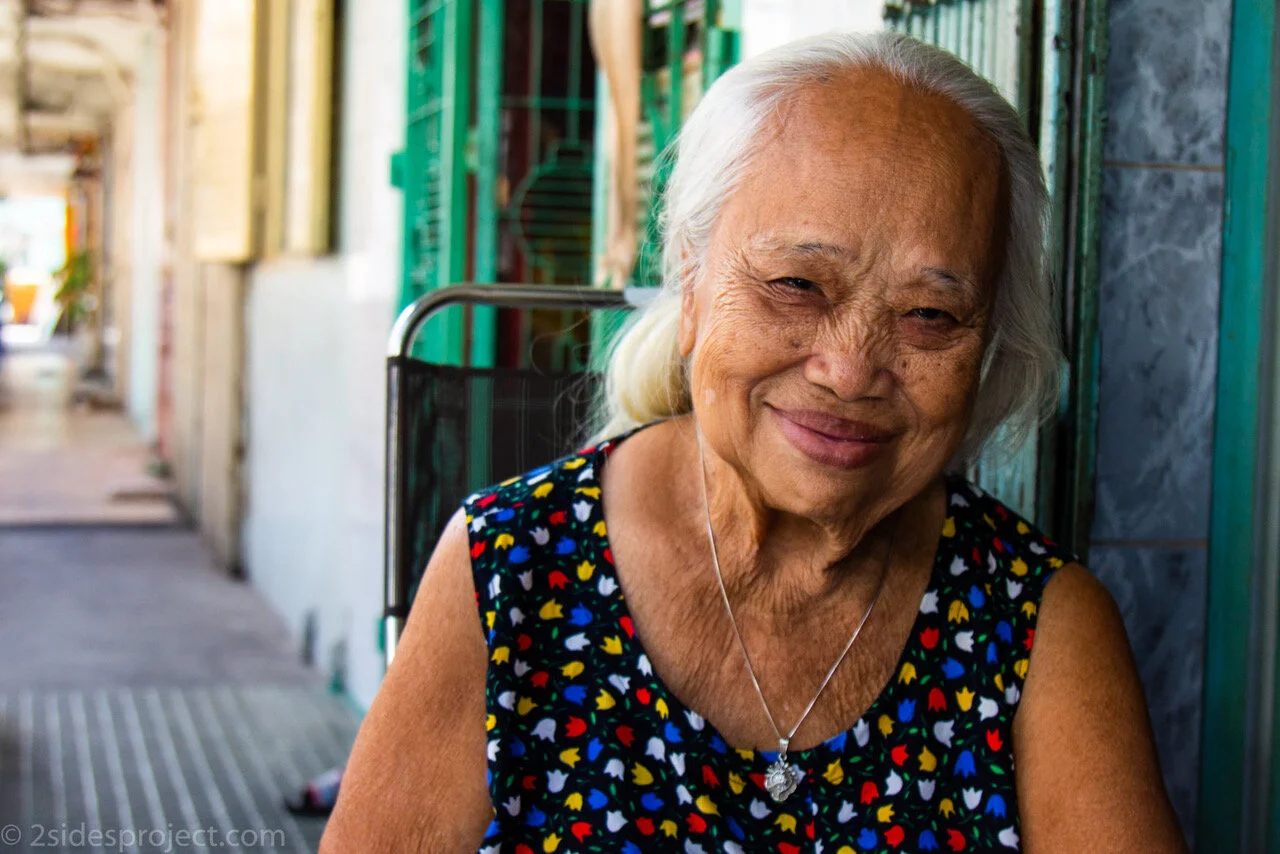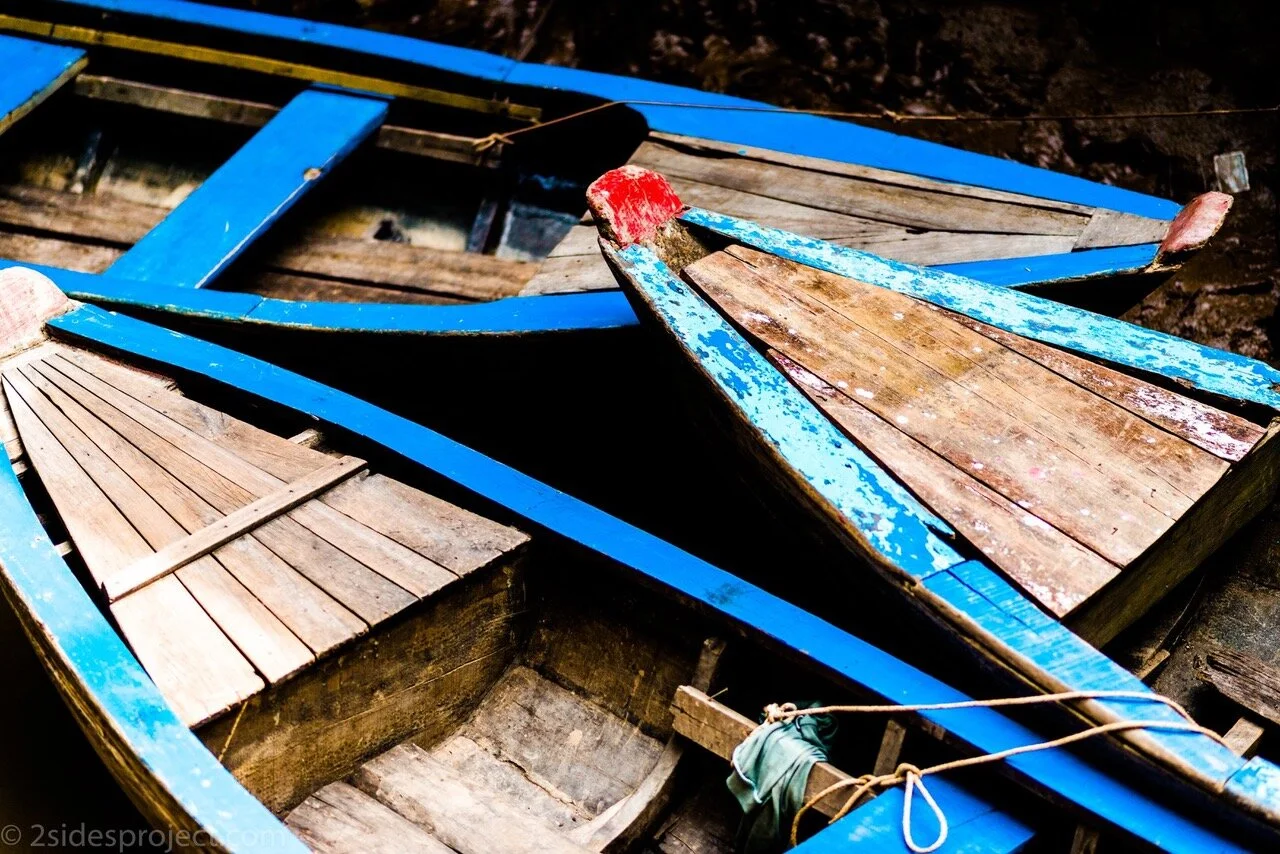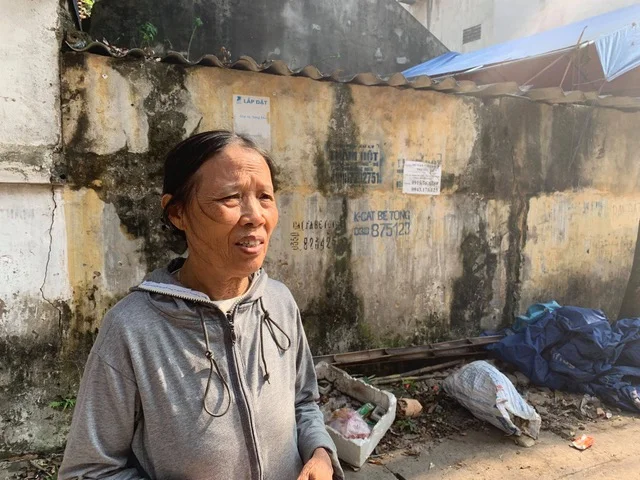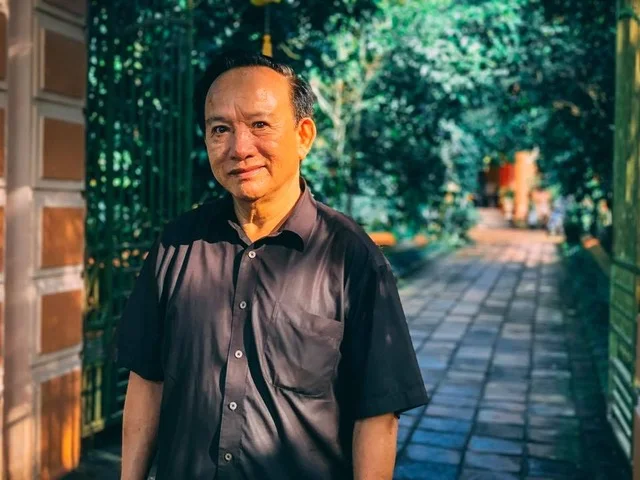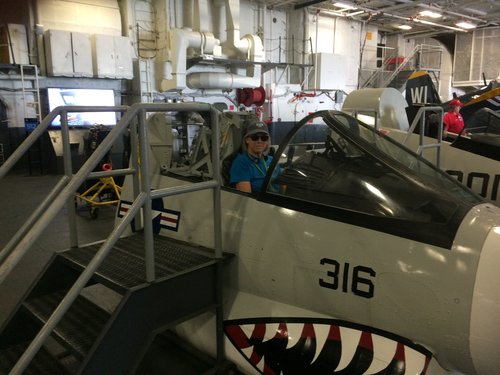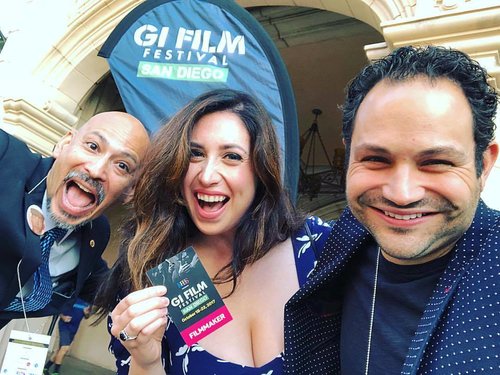Stories
Preparing for Vietnam: The 2 Sides Project 2024 Trip Participants Share Their Pre-Trip Excitement
Margot: Do you all have any expectations about the trip?
Mike Walling: Truly, my expectations are to just go and embrace and enjoy. The highlights would be visiting our sites and having closure, and I look forward to interacting with the Vietnamese sons and daughters.
Dina Walling: I am beside myself with excitement about every minute of it. All the sites, the sounds, every aspect of it. Obviously I'm really excited to see all your dads’ sites. I’m thrilled to be able to have closure for them. It's like full circle from when I first came into the family. I remember one of the first conversations we had when we first started dating at age 17. Mike told me the whole story about his Dad and I was flabbergasted. I mean, I obviously knew about Vietnam, but I'd never had met anyone that lost a parent during the war or even a parent so recently. I thought a lot about what his mother had been through and his Dad's family. It always shook me and obviously still does. To see him and his brother Jeff be able to have this Moment, I don't even know what to say. It's so special.
Lisa Walling: It’s so interesting. Our son went to DC with Jeff in 2005, the year that Jeff and Mike’s mother died, and that's when they met Doug. They also had a meeting with DPAA and Jeff came back saying he’d met with an officer who said they had seen a site that they wanted to go in and go back to and excavate. It wasn’t until 2010 when they finally were able to go back in, and they got a call in 2011 that they had found their father’s remains. So talk about going full circle. Here we are together, going to Vietnam. It's insane. And to engage with the Vietnamese. That’s one of the things I'm most excited about.
Jeff Walling: Beyond hearing your stories, I'm looking forward to seeing what my father experienced in Vietnam. We know what he experienced living in Arizona because we live in Arizona, but we don't know what he experienced while he was in Vietnam. So I think going back there and walking in his footsteps and going to those places and experiencing the humidity, the jungle, the beach, those elements will really give us more understanding of who he was and he was doing and how he must have felt. I'm excited to feel that. People ask me why I want to go to the crash site. I guess it's just closure, right? It's actually something I've always wanted to do my entire life. It was something I never expected to be able to do.
Doug Godfrey: I've been thinking about and wanting to go too, but in the back of my mind thinking that'll probably never happen. You guys use the word closure. It's not closure for me. My life is complete without going. It's just I'm just looking forward to experiencing it. If I never got to do it, I'd be fine, but I think it's going to enhance my life.
Margot: Do you think that ambivalence is in part because your dad hasn't been found?
Doug: It wouldn't really matter if he’s found or not. But to me the coolest part is doing it with you guys.
Dina: Let’s turn the tables. What are your emotions, what are you looking forward to Margot?
Margot: Ever since I started the 2 Sides Project, my mission has been to bring people to that hallowed ground and to have them get a better understanding of the Vietnamese side, to get rid of any assumptions or antipathy or hate. I felt all those emotions throughout my life, and now it’s gone because I talked to and listened to Vietnamese sons and daughters. I hope to be a good group chaperone, too. Not just through the heavy, war-related sites or the emotional two sides meetings, but to the fun ones too, like places to get a two hour massage for $20, or going to a temple, or eating amazing food. Maybe it’s not what our fathers experienced, but it will be healing for all of us, on both sides.
The 2 Sides Project documentary was one of six films from Gold Star daughters and sisters featured at an all day screening event in Washington, DC. The films use powerful storytelling to share a greater understanding of the effects of the Vietnam War and included The 2 Sides Project, Blood Road, Sijan, Gold Star Children, They Were Our Fathers and He’s Only Missing.
The U.S. Peace Institute engages in research and dialogue examining U.S.-Vietnam relations, and is in the midst of a multiyear project to foster public education and dialogue among Vietnamese and Americans. The 2 Sides Project was honored to participate in its 1.5 day event in October 2022, the first in a “planned series of annual in person dialogues bringing together partners and participants concerned with multiple war legacy issues and U.S. relations with Vietnam and its Southeast Asian neighbors.” Participants on the main stage from USAID, the HCMC Peace and Development Foundation and the US Department of Defense talked about healing from the wounds
of war, while other breakout panels with the National League of POW/MIA Families, VUFO and the DPAA explored cooperative initiatives among US and Vietnamese veterans and families.
The latest 2 Sides Project Peace Home was officially handed over in September 2022 to its new owner, Ms. Mai, in a ceremony in the Cu Chi district. This home was donated by Jill Hubbs in loving memory of her parents, Bereth Hubbs, Jill’’s mother, and her father, Commander Donald Richard Hubbs, a pilot in the U.S. Navy who went missing in action on March 17, 1968 over the Gulf of Tonkin. Ms. Mai’s was a new kind of home, a partial rebuild of an existing house for a North Vietnamese veteran who was injured during the war and always struggled to make ends meet. With her children far away and her husband gone, Ms. Mai needed a safe and sound place to live. Now she has a new one bedroom home, equipped with a brand new stove, dining room table and fans to keep her cool, all provided by donations to the 2 Sides Project and by the local veterans who support
Ms. Mai today.
During the Vietnam War, the Ca Lu combat base was spread over a series of rolling hills near Route 9, close to Khe Sanh. On February 14, 1968, Navy Hospital Corpsman Larry Jo Goss was killed during a fierce attack by the North Vietnamese near the base on what today is known as Valentine’s Ridge. In December 2018, and again in 2019, on what would have been her father's 73rd birthday, Lori Goss Reaves visited the area with her son Casey to honor her father’s service and memory. That day she also met Ms. Hieu, who lives in the area. Lori was so moved by her situation that she decided to build a Peace Home for them in honor of her father. She was determined but overwhelmed. The area is remote and the construction cost -- $4500 -- double that of other homes we’ve built. Lori didn’t love the idea of asking for money. But she didn’t have to worry. People who knew her father and revered her family, and teachers who remembered her as a child, were some of those moved to contribute to build a home for a needy family. The home was completed in 2021 and officially handed over to Ms. Hieu.
We’re getting very close to fully funding our 7th Peace Home, initiated by Jill Hubbs, thanks to people like Tom Keating. Tom is the author of “Yesterday’s Soldier, A Passage from Prayer to the Vietnam War,” a different kind of war story that recounts his journey from Infantry Officer Candidate
(OCS) to conscientious objector. Tom has regularly donated to the 2 Sides Project over the years “because as a Vietnam Veteran who witnessed firsthand the destruction we caused, this is a way to help the Vietnamese people.” We’re grateful Tom for you and for all the others who are making peace a priority, and a reality!
Jill Hubbs’ mother, Bereth Hubbs, would have turned 100 years old today. Bereth had a lifelong passion for education and wanted to be a teacher. She finished one year of college away from home, but without enough resources to finish, and very homesick, she returned to Pensacola to take care of her widowed mother.
Bereth raised Jill in a home where school and studies were a focus, and what an impact she made! Jill graduated from college with degrees in elementary and early childhood education and taught school for 15 years. She was later appointed Director of Educational Services and Outreach at PBS affiliate WSRE, where today she is the general manager.
Education -- and her mom -- are still very much in Jill’s heart. So, what’s the best way to honor a woman who instilled great values and made an impact not just on Jill, but in all the lives Jill has touched since? With an education-focused Peace Home!
Starting today, on Bereth’s birthday, Jill is raising funds to build a Peace Home for a teacher in need in the area near the Gulf of Tonkin where her father, Commander Donald Richard Hubbs, a pilot in the U.S. Navy, went missing in action on March 17, 1968. Jill also hopes to offer school supplies and resources to an area school.
The 2 Sides Project is working with our partners in Vietnam, the Vietnam USA Society, to help us find the greatest need in the area. Our goal is to raise at least $2,500, the average cost for a peace home in Vietnam. Ready to help? Donate at https://www.2sidesproject.com/donate, and specify your donation is going to the Hubbs Peace Home.
Thank you for any and all contributions! We’ll update you as we identify a teacher in need, and a groundbreaking is scheduled.
Before and after: The home of Ms. Thach Thi Huong and her family was in bad condition, and they didn’t have the resources to repair or replace it. The family, which has three people with disabilities. needed help. Fast forward a couple of months and thanks to the generosity of Stephanie McLellan-Reyes, Ron Reyes and many of you supporting the 2 Sides Project, the family now has a new place to live! Thank you all for your incredible support for this Peace Home in Bac Lieu.
I had the great honor to meet Daryl Davis and Scott Shepherd at the premiere of their documentary Accidental Courtesy at SXSW. These are two men who were on opposite sides, but they sat down to talk, and to listen, and that made all the difference. https://www.nytimes.com/.../racism-politics-daryl-davis...
After several months of delays due to flooding, Covid complications and more, we’re excited that construction on THREE Peace Homes begins this week! Stephanie McLellan-Reyes raised funds to build a home for the family of Ms. Thach Thi Huong in Bac Lieu. Construction starts May 18 and will take one month. Ron Reyes raised funds for a home for Mr. Ho Am Pong’s family in the Khe Sanh area and Lori Goss-Reaves raised funds for a home for Ms. Ho Thi Hieu in the area of the Ca Lu combat base. Construction on those two homes starts May 20 and will take two months. All three families are very poor and in need of more stable homes. We are so grateful to our Vietnamese colleagues including Nghi Bui, Yen Tran and Hong Diem Nguyen who worked with the local authorities to find families in greatest need, and to all of you who donated funds to make this possible. We’ll keep you posted on the progress!
We were thrilled this week to virtually present the 2 Sides Project story to students at Catholic Memorial High School outside of Boston. Vincent Bradley teaches a class called “The American War in Vietnam” to juniors and seniors at the school, and opens his classroom to veterans and others with personal experience with the war to share their stories. We’re grateful for teachers like Mr. Bradley who make sure young people hear many sides of the war story.
This is the current home of Mr. Nguyen Van Thoi, who lives in Bac Lieu, Vietnam. Mr. Thoi’s house is made in part from the leaves of local trees. It’s in bad shape, and you can see its sides are damaged beyond repair. But on Monday, March 29, construction will begin on a Peace Home for Mr. Thoi. Spearheaded by Stephanie McLellan-Reyes and Ron Reyes, and funded by donations from so many of you who support the 2 Sides Project (thank you!!), the Peace Home will take about a month and a half to build.
Stephanie chose this location for a Peace Home to honor Francis Xavier Truong Buu Diep, a Vietnamese Catholic priest who served the people of Bạc Liêu Province and was killed on March 12, 1946. March is also a significant time for the Reyes family. Ronald Reyes, Ron’s father, was killed in action on March 30, 1968.
Mr. Thoi’s house is the first Peace Home to be built in 2021. Two more are about to be scheduled. We can't wait to share the progress with you!
Then and now: In December 2018, we planted a Peace Tree in the Martyr’s Cemetery where many of our Vietnamese friends’ family members were laid to rest. Sisters Diem and Que recently visited the cemetery to honor their loved ones, and they sent this picture to show how the tree is flourishing. Peace grows when the seeds are planted!
Happiest of birthdays to Diem, one of the first Vietnamese daughters we met, and one of our longstanding friends. Diem has introduced us to dozens of Vietnamese sons and daughters who lost fathers on the opposite side of the war. She has worked with us to build Peace Homes in Vietnam. And, as an executive with HUFO, a government organization building bridges between Vietnam and other countries, Diem has made it her life work to bring peace to all. We are proud of your work to heal the wounds of war, and honored to call you sister. Chúc mừng sinh nhật!!! Photo courtesy Quinn Ryan Mattingly.
Another Peace Home is fully funded!
A few short months ago, Lori Goss-Reaves (pictured here with her parents) started fundraising to build a Peace Home in the area where her father, Navy Hospital Corpsman Larry Jo Goss, was killed on Valentine’s Day in 1968. She was determined but overwhelmed. The area is remote and the construction cost -- $4500 -- double that of other homes we’ve built. Lori didn’t love the idea of asking for money. But she didn’t have to worry. People who knew her father and revered her family, and teachers who remembered her as a child were some of those moved to contribute to build a home for a needy family. Today we’re overjoyed to say that this home is fully funded, and construction can soon start. Thank you to ALL those who support the 2 Sides Project. Your open hearts made the construction of three Peace Homes possible in 2020 and have already funded the construction of three more in 2021. We may not be able to meet the other side in person just yet, but your support means we can continue our work to heal the wounds of war in new and very effective ways.
We just learned of the passing of HM3 Steve “Doc” Lakernick. If you’ve seen the 2 Sides Project documentary, you know that Patty Young Loew grew up with questions about how her father died in Vietnam. After the 2 Sides Project trip, she reached out to a group on Facebook, and Doc, who served under Patty’s father, responded. He was able to share the details about what happened on March 11, 1969, the day that Jack B. Young was killed. A few years ago Patty and Doc were able to meet in person. We celebrate this wonderful man, for his service, and for bringing healing to Patty and her family.
On this day five years ago, six American sons and daughters who lost fathers in the Vietnam War went to Vietnam.
Two years later, an award-winning film about that experience was launched around the world.
Since then, we’ve hosted Vietnamese visitors in the U.S., journeyed again to Vietnam, met with more than 60 Vietnamese sons and daughters, held more film screenings in the U.S. and Vietnam, been included in university-level curriculum, and celebrated stellar photography at an exhibition. Even in this exceptional year, you have made it possible for us to continue to bring the healing full circle, with the building of three Peace Homes in the An Giang province of Vietnam. Three more homes are largely funded and planned for 2021.
We are grateful to the big hearts at Istrico Productions for being with us on this journey, and for all of you who have supported us these last five years. And we’re grateful to the Vietnamese sons and daughters who are now our brothers and sisters in loss. Each of them received this two-sided medallion, a reminder that there are two sides to every truth, and that healing comes when our ears and our hearts are open to hear them.
Peace Home #3 is complete! The family of Phan Ngoc An, Luong Thi Lac (husband and wife) Nguyen Thi Phi (grandmother) have settled into their new home, built where the old one stood, and thanks to the love and generosity of our 2 Sides Project family.
We knew the family needed a home. What we didn’t know until we started construction was that Mr. An, who is handicapped and can’t walk, had no way of getting around on his own. So we decided to buy him a wheelchair too, and made sure the home had a ramp so he could easily move around. Thanks to his newfound mobility, Mr. An recently secured a job harvesting corn, which his wife now sells at the market.
See what happens when, together, we take a painful past and make it a positive future? The effects just keep rippling on in our hearts and lives. Thank you for helping us make this happen, a special thanks to Susan Mitchell-Mattera, who spearheaded this initiative to build a home in the province where her father, James C. Mitchell Jr., was killed in January 1970. His memory, your generosity and these good works are forever linked.
Stay tuned for more Peace Home opportunities! Donate now!
On July 27, Martyr’s Day in Vietnam, we’re thinking of
all the Vietnamese sons and daughters we’ve met along
the way, especially the students from the Ly Tu Trong
School in Saigon. They lost fathers, and sometimes
mothers too, on the opposite side of the Vietnam war,
and today they honor their parents’ memory. We wish
their families peace on this important day of remembrance. Portraits of LLT students taken on and around campus
in February by Quinn Ryan Mattingly.
The 2 Sides Project was featured in a four-part article this week in Vietnam’s Bao Tin Tuc newspaper. Timed with the 25th anniversary of the normalization of relations between Vietnam and the United States, the articles give a wonderful overview of the project’s work in the past five years, and more details about the lives of two of the Vietnamese sons and daughters we met and cherish: Mr. Xiem and Ms. Diem. Links to all four articles, which include new photos of Diem and Xiem as well as the Peace homes that were recently built. You can switch to English on any of the articles.
Vietnam’s Bao Tin Tuc newspaper four-article:
Article 1
Article 2
Article 3
Article 4
It was 25 years ago today that Bill Clinton announced
the normalization of diplomatic relations with Vietnam.
Vietnam is now the 13th largest U.S. trading partner and
the top ASEAN exporter to the U.S. Significant U.S.
government funding helps to de-mine and clear the land
of bombs, and provide humanitarian assistance. And in
this new world, the 2 Sides Project is able to work with the Vietnamese government to connect sons and daughters who
lost their fathers on opposite sides of the war. Here’s to
the next 25 years of continued healing, prosperity
and friendship.
These Sandbags protected bunkers at the Khe Sanh Combat base, a key post for U.S. Marines during the Vietnam War and the site of fierce fighting during the Tet Offensive. Ronald Reyes, PFC U.S. Marines, was killed during battle on March, 1968. Today his son Ron Reyes wants to build a peace home for a needy family in the area, and, with his girlfriend Stephanie, a second home south in Stephanie’s hometown of Bac Lieu. Getting a home with all the necessities built in the more mountainous region of Khe Sanh costs $3500, in Bac Lieu its $2800. The two have already raised $2500, and with your help will get to their goal of $6300. If you’re able, please consider making a donation to make these peace homes a reality.
Photo courtesy Anthony Istrico
Since we can’t travel, we’re bringing Vietnam to you! This is Saigon Smoke, Nora Kubach. “This photograph happened in the span of 30 seconds. There was a guy selling cigarettes in the markets. I saw a man on a bike reaching into his pocket to get money. He had a cigarette hanging from his mouth, and he went to pay the guy for another pack. I took this while he was waiting for the cigarettes to be handed back to him. He looked at me for a second and I lifted my camera to ask if I could take his picture. He just kind of nodded, and I snapped it. The smoke in the shape of a heart as just a happy accident. When I took the picture I can smell and hear the city on a busy Sunday morning when everyone is out and about, running errands.” Saigon Smoke and more stunning photographs from Vietnam are available in any size here.
This week, the Nguyen Thi Luom and Nguyen Thi Thom families became the first two recipients of Peace Homes in Vietnam. They celebrated with officials from the People’s Committee of Cho Moi District, who helped the 2 Sides Project identify families in need and oversee construction.
Susan Mitchell-Mattera had the idea to build a Peace Home in the area where her father was killed during the war. “At first this seemed like such a big task, but when I told people what I wanted to do, a whole community came together in support. Gold Star children and wives, my church community, family,
and so many friends of the 2 Sides Project all contributed to make not just one but two homes possible. Now we can share
in the joy of seeing these smiling faces. It’s perfect timing with Memorial Day coming. Our fathers would be proud we are turning tragedy into service to others."
The Peace Home initiative continues! Susan expects to complete fundraising for a third home in the An Giang Province this year, and Ron Reyes and Stephanie McLellan are on their way to raising funds needed to build two homes in the central part of Vietnam. We are grateful for your support at https://bit.ly/3cRT2Hx
Nguyen Thi Dao’s first teaching job after the Vietnam/American War was at the Ly Tu Trong (LTT) School, her first assignment a group of students who often screamed uncontrollably and refused to study. On a particularly challenging day, she ran to the school disciplinarian, Tran Trong Duc, for help. When he arrived at the classroom, the students were sitting quietly. Duc glared at Dao, spun around, and left. From then on, he teased her mercilessly. But he also secretly courted her, leaving a small package of che, a Vietnamese sweet dessert, on the ledge near her office every day. With food so scarce, the sweet was a precious treat. Dao eventually discovered the che was from Duc. They became a couple and later married in a ceremony in the school’s library. Over the years, Duc and Dao taught hundreds of students, all children whose fathers, and sometimes mothers, too, were killed fighting for the North Vietnamese. To this day both Dao and Duc are revered by the many men and women they raised. Photo of Dao, who turns 65 today, on the LTT campus courtesy Quinn Ryan Mattingly.
We're officially starting our college chapter! Temple University Television, one of the largest academic stations in the country, will air The 2 Sides Project documentary this summer to more than 55,000 students and faculty, and to Philadelphia area residents via Comcast and Verizon. So exciting to be reaching new audiences with this powerful and inspirational film by the talented team of Anthony Istrico, Nora Kubach, Jared Groneman and Marco Duran and with the support of WSRE and Jill Hubbs!
Today marks the 45th anniversary of the end of the war in Vietnam. Our wish for peace on this day goes to the people
left behind on both sides of this war. Some returned home from the fight forever changed. Others restarted lives in new places. Many were children who bore the scars of loss as they grew up without fathers or mothers. This week also marks the 5th anniversary of The 2 Sides Project's founding. Our hope as we consider the long aftermath of this war is that we can continue to foster understanding and healing, one connection at a time.
Photo credit: Anthony Istrico.
Kim Carlson Benner and I got a chance this week to once again share our personal and 2 Sides Project experience with senior students in Mr. Vincent Bradley's Vietnam War history class at Catholic Memorial Schoolin Boston. This invite means the world to us. We get a chance to help students go beyond the textbook and learn more about the personal impact of war, from both sides. Mr. Bradley is an exceptional teacher who looks for ways to make history come alive for his students, through veterans, children and others with Vietnam experience. We're grateful to have had the chance to help these future leaders understand the true impact of war.
February 19, 2020 marked the 50th anniversary of the death of
Nguyen Tu Hai. We heard the story of his life from his daughters,
Hong Diem Nguyen and Nguyen Thi Hong Que. They also told us
about the story of their mother, who died in the war as well. The
sisters showed us some of their most cherished and personal belongings, including their father's books and reading glasses, their mother's
watch, and their parents' military medals.
2 Sides Project Founder Margot Carlson Delogne travelled to Vietnam to hear more about the North Vietnamese side of the story. She spent a day on campus with teachers and students of the Ly Tu Trong boarding school in Ho Chi Minh City. Pictured L-R: Nguyen Thanh Hung (student), Tran Trong Duc (teacher), Nguyen Thi Dao (teacher), Tran Van Anh (student, and apparently a quite mischievous one), Margot (2 Sides Project founder), Nguyen Hong Diem (student). Mr. Duc and Ms. Dao raised 1,500 students at the school after the war ended, children who lost fathers, and sometimes mothers, too, fighting for the North. But the story of the school starts back in 1971, deep in the jungle where, as Ms. Dao says, it was "built from leaves." Tunnels hid classrooms and the hammocks where the children slept, all covered in the Trung Quan leaf, chosen because
it was fire resistant.
James C. Mitchell, Jr. was killed on January 8, 1970 near Cao Lanh City. Susan honored her father's memory in a ceremony
on her last trip to Vietnam, as villagers near the site of his helicopter crash gathered. Today Susan (Senior Advisor to the
2 Sides Project) and her sister Pamela are reflecting on the 50th anniversary of their father's death by looking ahead. They have pledged to build the first “Peace Home” in the province where their father died, to be given to a needy family. This home is a pilot project with the 2 Sides Project’s partner in Vietnam, The Vietnam USA Society (VUS), and is the first of other programs that we hope to develop with partner organizations, so that we can not only foster connections between the two sides, but develop a positive outcome for future generations.
Air Force Captain John W. Carlson was killed on December 7, 1966 near Bien Hoa, Vietnam. Captain Carlson's exact crash location is still a mystery, and his remains have never been
found. Last year, his daughters Kim Carlson Benner and
Margot Carlson Delogne visited a site that was a likely
candidate. Onlookers included local officials, who cleared a
path for the sisters to pay tribute to their father in a nearby
field. Nora Kubach's photograph from that day is called "Looking for Answers," the perfect description for the
experience of the families of the missing.
In The Office, by Jared Groneman. "I took this from the bus as we passed a rice patty. I took the shot really quickly, but I thought it was kind of detached. I mean, this is what you think of when you think of somebody working. But this is all you see. You don't see what the rest of the farmer's life is like. The colors were really evocative, too. The whole country was green. It was all so saturated.”
Photographs from the 2 Sides Project trips to Vietnam: Hoa, by Nora Kubach.
“I toured the city in the early morning with photographer Quinn Ryan Mattingly. He took me to places I wouldn’t have known to go, where there are no Americans and no tourists. He taught me a lot about how to approach people you want to photograph. He said just go right up to them and start a conversation. We did that with Hoa. She told me she had worked at the airport during the war, that she loved her colleagues and loved the Americans. She showed us pictures of her grandchildren. It was instantly intimate. She had the same warm, friendly spirit of everybody we met. There's such a story in her face, this down to earth quality that I just thought was really sweet and beautiful.” Hoa and more stunning photographs from Vietnam are available in any size at http://bit.ly/2SwXK4n.
Bonnie Dean and Pham Dinh Thu. Bonnie’s father, Air Force Captain Robert N. Brumet, was a career officer who was killed in 1964. His death was widely reported because his plane was carrying too much ordinance, and it crashed into a home, killing a Vietnamese woman and her three children. The incident helped end the use of training jets for combat. Thu, one of four children, has few details about how his father died. He knows only that he was fighting in the dry season in 1968, that he was in the transportation battalion, and that he died when he reached the southwestern part of Vietnam. Thu said he felt very emotional meeting the other side in Hanoi. “I hope our fathers in heaven will bless us.”
Congratulations to our sister in loss Jerilyn Brusseau, who has done so much to help restore peace between Vietnam and the United States. She is a mentor and a friend, and one of the kindest people we know! We are grateful to learn from her example and that of her mother Rae how to help heal the wounds of war on both sides. We were privileged to speak to both Jerilyn and Rae a while back about Jerilyn's brother, Daniel Bernard Cheney, a distinguished COBRA pilot who was killed in 1969. Jerilyn and Rae shared their experience and life work with PeaceTrees Vietnam in this moving interview: https://bit.ly/2lZEgcb Photo courtesy Jolly Delphi.
Photographs from the 2 Sides Project trips to Vietnam: Blue Lines, by Anthony Istrico
“We had traveled in these little rowboats down a very narrow stream of the Mekong River. I looked down from the docks and saw the most beautiful shades of blue. The colors just jumped out at me. This ended up being one of my absolute favorite shots from a composition perspective. The lines just seem to cut across the frame.” Blue Lines and more stunning photographs from Vietnam are available in any size (and purchases benefit the 2 Sides Project!) at https://bit.ly/2SwXK4n.
Martyrs Day, Vietnam, 2019. An honor for Ron Reyes to attend a meeting on this day with fellow Vietnamese sons and daughters who lost fathers on the opposite side of the war. We know well that “war does not determine who is right, only who is left.” To our brothers and sisters on the Vietnamese side we say peace to you, peace to your families, peace to all.
At the opening: Bui Van Nghi, (far left) former prisoner Robert Chenoweth (third from right), Robert's son Sean (far right), Chuck Searcy (center) and 5th from left Tim Wilbur, son of POW Colonel Robert Wilbur. Hanoi, 2019
Our partner in Vietnam, the Vietnam USA Society (VUS), and its
Secretary General Bui Van Nghi provided many of the background and materials featured in the “Diary of Peace” exhibition, whose opening
in July 2019 at the Hoa Lo Prison (the “Hanoi Hilton”) welcomed former
prisoners and others from both sides of the war. The exhibition highlights examples of efforts to foster reconciliation, mutual understanding and friendship between the people of Vietnam and the United States, including the 2 Sides Project!
Peace to all from Kim Carlson Benner and Van Thi Kim Cuc, who lost fathers on opposite sides of the Vietnam War. Kim’s father, Captain John Carlson, was killed
when Kim was four years old. Cuc’s father was killed by a bombing when Cuc was
nearly two years old. Both women rarely talked about their fathers as they grew up,
or even as they grew older. Kim says, “As a child, I felt invisible at times. When
people did pay attention to me, it was because they felt pity for me, which made me embarrassed.” Cuc said she wanted to hide her background because she did not want
pity either. And as she worked hard to become a psychiatrist, Cuc did not want people
to think that “the success in my life wasn’t because of my own efforts but because the government had helped my family.” Cuc said she had two wishes after meeting Kim
and other Americans. “That we solve the issues related to Agent Orange, and that all wars stop.”
Kim Carlson Benner and Van Thi Kim Cuc, Hanoi, 2018
Le Van Trung, Saigon, 2018
This man's nickname as a boy was "The Prisoner Without A Number." He is Le Van Trung. His father was killed in October 1967, and four years later his mother was exposed as an enemy. She escaped capture. Trung did not. The five year old was taken
by armed forces to a prison, where he stayed for two years. He was the only child in
the prison, and was so young he could not be issued proper documentation. From
that moment on he was known simply as “The Prisoner Without a Number.” Trung’s mother, who was serving in the army in the jungle, never stopped looking for her son. She wrote a letter to the district officials asking for help. They finally found Trung,
who had moved to the Ly Tu Trong School to be raised with other orphans. In 1975,
he walked hundreds of miles, and was finally reunited with his mother.
On the morning of October 10, 1967, students in the village of An Loc Thuong took their seats in physics class. They were 15 minutes into their studies when a bomb hit the school. In an instant, 33 students and one teacher were killed. Only 15 people survived. Today, we met with five of the survivors. One of them was Mr. Xiem. His father was killed in the war, and he is featured in The 2 Sides Project documentary. He introduced us to his classmate Pham Thi Ngu. Hours after the bombing, rescuers found her alive under a table. Her legs were broken, and her head and back injured. She was 17 years old at the time. Ngu never fully recovered or married, and today still lives in the village just a short distance from the tragedy. We visited the site and planted a tree to honor those who died. War may leave its scars, but new beginnings are ours to make.
Pham Thi Ngu, An Loc Thuong, 2018
Cu Van Huu, Y Yen District, 2018
Magic and miracles abound on this 2 Sides Project trip to Vietnam. This man approached our group in the Y Yen district and showed us an identity card that he said his father found scavenging a crash site during the war. It is an official Armed Forces of the United States ID card, and it's clearly marked with the name, picture and fingerprints of a US airman. We were stunned to hold the card in our hands. And we were grateful when, after hanging onto it for decades, the man decided to give us the card to return to the airman's family. We jumped online to find out more, and in less than 12 hours, were on the phone with the airman's daughter and one of his sons. They told us their father's remains were finally identified and returned to them in 1985, everything but this card that will soon be in their hands. Open hearts and open minds on both sides made this miracle happen.
Vo Hung Tien grew up with mixed feelings about the American GIs who made camp near his home. They had killed his father, and later one of their bombs injured Tien when it hit near his school and a window shattered, spraying his body with glass. His friends carried him away to get help, and when the GIs saw them, they brought Tien
to the barracks and cleaned his wounds and bandaged him up. From that day on they looked out for him, inviting him to play games, buying him brushes and polish so he could earn money cleaning their shoes, and sending him home with canned food for
his family. One day the Americans led him toward a helicopter. They wanted to give Tien an aerial view of his country. He thought he was being kidnapped. His friends
ran to his mother and told her Tien had been taken away. But Tien returned safely,
with a great story to tell.
Vo Hung Tien, outside Saigon, 2018
Tran Trong Duc and Nguyen Thi Dao, Saigon, 2018
During the Vietnam War, Tran Trong Duc and Nguyên Thi Dao were teachers
at a boarding school for “children of war martyrs.” They taught and cared for
hundreds of Vietnamese orphans, some as young as six years old. Over the years
they became so close to the children that they remained in touch with many
students well after the war ended. We met Duc and Dao, along with seven of
the students from the school, in the 2 Sides Project meeting in Saigon. They
have an unbreakable bond that has seen them through loss, and love. Duc and
Dao met at the school and later married, as did 90 couples who were students.
Thai Cong Nguyen, Hue, 2018
Thai Cong Nguyen’s story is filled with loss. Among the 20 people in his family killed
in war are his father, who fought and died during the French war, and five of his siblings, who all died fighting in the American war. Some are still missing. Nguyen fought in
and survived the American war, but walks to this day with a limp because of injuries
to his leg. He invited us to stay in his home. In the morning, he brought us to the
alter on the third floor, where he prays for his family. Today he said a prayer for the
dead on both sides, and as he did, music from the temple across the street floated over and around us. Our translator said it was a service for the dead, and specifically for
those who are still missing, the wandering souls who are searching for home. There
are 300,000 people still missing on the Vietnamese side and 1,600 on the US side.
Until they all, on both sides, come home.
Nguyen Thi Luong and Margot Carlson Delogne, Hanoi, 2018
In 2015, the 2 Sides Project went to Hanoi to connect sons and daughters who
lost fathers on both sides of the Vietnam/American War. Six Americans met seven Vietnamese in that first meeting. In 2018 we went back to Hanoi, and more than
double that — 15 Vietnamese sons and daughters— came to meet us. All had lost
a parent in the war. Some had never met an American. One, from the start, grasped
our hands, embraced us warmly, held us close to her side. Her name is Nguyen Thi Luong. We learned her mother was the one who died, She was a kindergarten teacher who was in school one day when a bomb raid began. She rushed the children to
the bomb shelter, and when she went to bring the last child to safety, a bomb hit.
She protected the child with her body and lost her life. In these moments, we are reminded of the power of connection, of shared experience, and of forgiveness, all
of which live in Luong.
2 Sides Project Profile: Bonnie Dean
Bonnie is the middle child and youngest daughter of Air Force Captain Robert N. Brumet, who was killed on April 9, 1964 when the wings on his overloaded plane fell off and he crashed into a home. The incident also claimed the lives of a Vietnamese woman and her children. Bonnie was five years old when her father died. Her memories of him are few, but reflect a resourceful and fun loving man, one who took great pride in his family.
Today Bonnie is a self-professed geek who analyzes data for Partners Healthcare in the Boston area. She’s also a sports fanatic. Bonnie followed her three sons’ high school and college hockey games and mountain bike races, and has even done some pretty competitive sports herself (that’s Bonnie pictured below competing in a canoe race.)
Bonnie is one of “seven sisters” going on the 2 Sides Project 2018 trip, which takes off on Saturday, November 24. One of the seven is her sister Barbara, who went to Vietnam in 2009 and jumped at a chance to return with Bonnie. Now Bonnie hopes to get to know the country and its people, and to go to that place she’s thought about for most of her life – the site where her father’s plane went down.
Bonnie at the Vietnam Veteran’s Memorial in Washington D.C. on the 53rd anniversary of her father’s death.
Do you have any memories of your dad?
I’m not sure how old I was, but Mom was making a cake and I wanted some of the batter, so I stuck my finger in the bowl with the egg beater on. My hand got all tangled up, and I remember my dad tried to get it out, but ended up having to cut the egg beater off. We went to the hospital and, thankfully, there weren’t any broken bones. That was a traumatic memory, but I have fun ones, too. We kids used to play a game where we’d stick our heads into the back of the sofa and flip our legs over the back and stand up on the other side. Dad thought that looked like fun so he tried it, but he was too big, and the couch went over with him and fell on top of him. We all laughed, and so did he.
He sounds like a fun guy.
There were always parties at our house, family picnics with lots of games and laughs. My mother often said that when you got with the squadron, it was expected that everyone would have fun, and have a little too much to drink. When my parents had people over we would come down in our pajamas and salute everyone. My dad was fun loving but he was also known for helping others out. His nephew was having some trouble at home and came to live with us for a while. My dad was really proud of his family.
Trying out the fighter jets on the USS Midway aircraft carrier in San Diego.
What do you remember about the day your father died?
Only that we were sitting in the basement crying. I guess that’s when Mom told us. And I remember the funeral and the fly by. That was all pretty dramatic for a five year old.
Did things change for you from that moment on?
My sister and brother were closer to my parents than me, so it didn’t change my life as much as theirs. I always felt really independent. I don’t like to depend on others. Part of that comes from losing my father. I don’t know what will happen to people; they could just be gone like that, so I never got too attached to people or places. That was probably the most influential outcome. My father’s death changed my personality.
Family photo, early 1960s. Bonnie is on the right, brother Woody is in the middle, and Barbara is on the left.
You had a chance to go to Vietnam when your sister Barbara did. Why didn’t you?
I had some lame excuse I can’t remember. I think if she would have pushed me I would have gone.
Why now?
I was never brave enough to read a lot of books about the war, or watch movies about the battles. It’s all too gory for me. I can’t take it. But I want to see the country, I want to see what the battle was about. I know it was a power play and my Dad was a pawn in the whole thing. But I want to see the people. They suffered way more than we did. They are a very resilient people. They just don’t just let anyone roll over them, they fight for what they want. So I’m curious about the country and the people and how they rebounded. I think I’ll find that it’s a place worth fighting for.
Bonnie competes in a canoe race in which racers have to jump out of the canoe and get back in it before they can finish.
Do you feel any trepidation about going?
I think a few things will be difficult. I mean how do you show or express how sorry you are to someone who lost their whole family, not just their father? How do you get them to understand? I don’t know how that will be, but I still want to meet them. On the positive side I’m expecting the geography to be spectacular. I’ve always heard it’s a beautiful country, that the beaches are beautiful, and I’m interested to see the jungles. I’ve heard about the jungles, about our use of Agent Orange, about how we didn’t know how to fight a battle in that kind of environment. It’s going to be very different.
Hiking the Franconia Notch loop in New Hampshire with family.
What do you hope most happens?
I hope to close the loop. I hope I get closer to my father. I’m going back to my roots in a way. My dad is gone. It’s not his fault. He would be here if he could be. I’m expecting to be moved, I’m not sure how, good or bad, it will be such a different experience than anything I’ve done before. So I’m leaving myself wide open. I’m trying not to create expectations.
The 2 Sides Project Profile:
Susan Mitchell-Mattera
Susan is the daughter of James C. Mitchell Jr., an Electricians Mate in the Navy and a linguist who learned several languages at the California Linguistics School before he left for Vietnam. He was on assignment with Special Forces Operations on January 8, 1970 when his helicopter was shot down over the Mekong Delta near An Giang. A registered nurse from California, Susan often finds herself caring for Vietnam veterans. But it’s only been in the last few years that she has pushed herself to ask about their experience, and to share her own, fostering connections that have propelled a deeper interest in helping others heal from the war.
Outside of her work, Susan serves others in many ways. She is a volunteer at her local church, working most weekends on projects that help the community’s neediest. She is also a caring sister to many other sons and daughters who lost fathers in the war, someone who makes a point to collect and share rubbings of their father’s names when she visits the Vietnam Memorial in Washington D.C. And Susan has been an active supporter of the 2 Sides Project from the start. She went on the 2015 trip, has attended film premieres in London and Florida, and regularly speaks to individuals and groups about her experiences. Susan’s passion and drive led to her recent appointment as a Senior Advisor to the 2 Sides Project. She will serve as an advisor to the trip’s participants, and continue to be an international Ambassador of Hope.
In this profile, Susan talks about what propels her to serve, the special moments she remembers from her first trip to Vietnam, and how her experience shows that sharing stories is one of the most powerful ways to connect with others.
Early family photo, with Susan on the right
First, happy early birthday. You share it with Veterans Day. Does that explain in part why you’re so active in veterans affairs and war-related service?
I think it’s part of my genetics. My grandparents came from a place of helping others. They taught us that in order to fulfill your purpose, you have to empty the cup. They passed that idea on to my mother and to us, so we’ve always been active in all kinds of community efforts.
I think over the last 10 years I’ve centered more on vets, connecting with them and their stories. Before that I would see vets and wouldn’t be comfortable even saying thank you. But I have forced myself out of my comfort zone and now it seems more of a mission to hear their stories, and to tell mine.
Susan in front of the dog tags exhibit, Chicago, 2018
Well it’s good you’ve moved out of your comfort zone because you have these magic moments in your life where amazing things seem to happen. We started calling them “Susan Moments.”
I just seem to be in the right place at the right time. A couple of weeks ago I went to Chicago on a stopover on my way to Washington DC, and had a whirlwind couple of days visiting the National Veterans Art Museum and the local Vietnam Veterans memorial. I saw the dog tags exhibit, which displays tags from all who served in the Vietnam War. I met Vietnam vets and heard their stories. And I met the museum director, who gave me a private tour. He also introduced me to the woman who created all of the dog tags using an old machine they stored in the office, which they restarted to make me a replica of my father’s tag. My family jokes that I’m living the life. I’m just connecting with people. That’s my purpose now.
Amy Bushatz, right, and Susan celebrate after the Marine Corps Marathon
You were also recently in Washington, DC for the Marine Corps Marathon, right?
Yes. Amy Bushatz is a reporter I met ten years ago when she profiled me during Father’s Day for The Washington Post. We’ve kept in touch, and she contacted me recently to say she wanted to carry a flag in my father’s name through her road races this year. She finished the season doing the Marine Corps Marathon, carrying the flag the entire way. She gave it to me after the race, and I’m bringing it with me to Vietnam.
Susan and Vũ Ngọc Xiêm in Ho Chi Minh City, 2015
What do you remember most from the first 2 Sides Project trip?
I’ve been looking back at all the pictures, all the moments. I will always remember one of the Vietnamese sons, Mr. Xiem, pinning a flower on my dress. It’s a clear plastic flower made by children who are living with defects caused by Agent Orange. He had been very angry in our meeting, and his hands were shaking as he put it on me, but I saw how his anger had softened as we all talked. His action symbolized there was some understanding, not necessarily forgiveness, but an understanding that we are all on the same side, the side for treating others with humanity and kindness. I still have that pin. It’s on my dresser. It’s as valuable to me as any piece of jewelry I’ve been given.
Why are you going back?
I have to. I think there are more connections to be made and more opportunities to help others close that hole in the soul that anyone who lost a father, on either side, knows about. That hole is now filled for me. I’m not saying everyone has to go to Vietnam to fill it, but I’ve seen people go who said they would never go, and come back changed. The question is why wouldn’t people want to grow and change? I can’t imagine being stuck in that timeframe when my father died. I know that the stories we brought back from the first trip helped others. Some can’t go or don’t want to go, but I still think they want to hear the stories.
Susan at the Washington, D.C.
2 Sides Project film premiere, 2017. Pictured are, left to right, Patty Young Loew, Susan, Jill Hubbs and Ron Reyes
What do you want from this trip?
I hope this time around that we reach more people on both sides. And I hope it opens other opportunities for us to work with other generations. We’re all getting older, entering our 50s and 60s. We’re starting to lose sons and daughters. I wouldn’t want someone to miss an opportunity to change or to heal, if they wanted it. Whether being there physically or hearing through others’ stories, words change people. And hopefully the words we bring back bring healing and hope.
2 Sides Project Profile: Jill Hubbs
It has been more than 50 years since Commander Donald Richard Hubbs, a Navy pilot, launched his aircraft from the USS Yorktown in the Gulf of Tonkin and, one hour into flight, disappeared off the North Vietnam coast. His daughter Jill was 10 years old when her father became missing in action. Years later, in 1993, she traveled to Vietnam on a quest to find any information about her father. Since then her interest in the war and its aftermath has only grown.
As Director of Educational Services and Outreach at WSRE, one of the U.S.’s premiere PBS television stations, Jill was one of the first to see the Ken Burns documentary series about Vietnam. She’s a filmmaker herself, producing, among other films, “They Were Our Fathers,” which features interviews with sons and daughters who lost fathers on the U.S. side of the war. And Jill is an avid supporter and fundraiser for “The Wall South,” a permanent half-scale replica of the Vietnam Veterans Memorial dedicated in 1992 in her hometown of Pensacola, Florida.
In this profile of one of the “seven sisters” going on the 2018 2 Sides Project trip, Jill talks about her father’s disappearance, the evidence her family later uncovered that indicated he may have survived the crash, and the hope she’s bringing on this trip.
Jill with a favorite family picture of her father saying goodbye before leaving on a deployment on the USS Philippine Sea, 1957
When was the last time you saw your dad?
When he was leaving for his second tour of duty in Vietnam in 1967, just a few days after Christmas. We waved to him as he stood on the deck of the USS Yorktown. Back in the car, I discovered the cake that my grandmother had baked for him – a lemon pound cake, his favorite. I begged my mother to let me run it back up to him, and she did. He took the cake, gave me a hug and told me to be good girl and take care of my mother. These words have became the marching orders that have echoed in my ears ever since.
What do you know about the circumstances of his death?
He went missing in action during a mission over the Gulf of Tonkin in North Vietnam. He and his three crewmates flew an S-2 reconnaissance aircraft off the deck of the USS Yorktown. One hour into their flight, the plane disappeared off the radar. Five hours after the last contact, radio signals were heard, and North Vietnamese fishing boats were spotted in the area the next day. My dad was declared missing, but I knew that other people in his squadron were searching for him, so I felt they would find him and everything would be ok. I was so young I don’t think I really understood the gravity of the situation or that my father was serving in a war zone and that America was fighting the North Vietnamese.
The Hubbs family in Taiwan. Jill is on the left, her sister Jayne on the right (1966)
Your father’s disappearance ended up being a high profile case.
We waited for news for days, which turned into weeks, then months, then years. In 1969 my mother and I identified my father in a North Vietnamese film of American POWs, but he didn’t come home when other POWs were released. In 1987 we received a live sighting report from the Defense Intelligence Agency stating that their credible source had seen my father alive being held with 13 other Americans near the city of Da Lat. Three years later I sat with my mother in the Senate Select Committee hearings on POW/MIA affairs and heard President Nixon’s defense secretaries testify that the U.S. government believed some American servicemen had not been returned, but had been left behind.
That must have been absolute hell.
Never knowing what happened to my father, living in uncertainty, was so very hard to cope with. My mother’s heart was broken, but she was my hero, making sure that my sister and I were raised in a healthy and happy home and in a way that would please my father. She carried on despite the obstacles, the heartache, the limbo. She had a very strong faith in God. That sustained her.
Jill meets Vietnamese children (1993)
You went to Vietnam before the United States had established any kind of diplomatic relations with Vietnam. Weren’t you scared to go?
My mother was very worried for my safety, but I wasn’t scared. I felt compelled to go. By the time we had received the live sighting report, I was an adult and I wanted to go to Vietnam myself to see what I could find out about my father. I traveled to Hanoi with a very small group from Friendship Force on the first ever trip to extend the hand of friendship and understanding after the war. I was unsure how I would be received by the citizens of North Vietnam, especially when they learned that my father was an American pilot who had flown missions during the war.
Jill, second from left, at the Wall South’s Reading of the Names Ceremony (2018)
What happened?
Everyone I met was gracious and friendly, including a mother who had lost two sons, both of whom had served in the North Vietnamese Army. She took a picture of my father and placed it between photographs of her two sons and began praying for all of three of them in a loud and emotional prayer in Vietnamese. It was a pivotal moment for me, a moment of forgiveness, understanding and shared grief. I did not understand her words, but I felt her emotion, her grief and her loss. And she understood mine. Before that journey, whenever I heard the word “Vietnam,” I thought of the war. From then on, Vietnam became a country to me, a place with people who became friends.
Jill, right, on the USS Yorktown next to a plane named in her father’s honor.
Did you get any other clues about your dad while there?
In Hanoi, I was able to locate an old Vietnamese grave registration that listed my father’s name on it, indicating that he had been buried somewhere in the province of Quang Binh. I have come to accept that I may never really know what happened to my father or ever be able to bury his remains on American soil. My mother died in 1999, never knowing the truth. What I have left are memories and the awareness that I am the legacy for my parents. It is my duty to honor them, live my life as they would have wanted me to do and to accomplish whatever I can to make the world a better place.
What do you expect from this trip?
I am looking forward to going with other daughters whom I have come to know and love like sisters. We are about to embark on a trip that will be life-altering for all of us, something none of us will ever forget and a journey that none of our fathers could ever begin to imagine us taking. We will also meet sons and daughters from the “other side.” Perhaps this is the most important part of our journey, being ambassadors of hope and friendship. It is a journey of the heart, a journey to embrace and honor the legacies of our fathers and a journey of peace and understanding for the future of our world. Our fathers would be very proud of us.
The 2 Sides Project Profile: Kim Benner
Kim Carlson Benner’s father, Air Force Captain John W. Carlson, was shot down in Vietnam in December of 1966. His remains have never been found. Decades on, his legacy lives in Kim’s life and in the lives of the two boys she has raised with her husband, Rich. Their sons, John and James, are named in memory of Kim’s father and that of his cousin, James Donahue, who was also killed in Vietnam in 1970.
In this series of profiles introducing the “seven sisters” who are going on the next 2 Sides Project trip in November 2018, Kim talks about growing up without her dad, what changed her mind about meeting the other side and going to Vietnam, and how she’s preparing for this important trip.
Kim fishing off the coast of South Carolina
What was it like growing up without your father?
It made me feel very vulnerable. I seem to remember being scared and afraid, always thinking that someone was going to physically hurt me. I am not sure how common it is for young girls to feel this way, but that's the way I felt all the time. I know I felt sad, like something was always missing.
Looking back, I think I really felt unmoored and adrift, floating alone in the world with no direction. Even though I was very young, I think in some way I knew I had to keep my sanity if I wanted to survive.
Did people talk to you about the war, given your family’s experience with it?
Not really. At times, I felt invisible, but when people did pay attention to me, it was because they felt pity for me ("that poor girl, her father died in the war") which made me embarrassed. I don't remember feeling particularly proud of my father and his service, or why anyone would even care. I don't even remember telling people about my father's death in Vietnam until much later. Friends of mine from high school recently found out about how my father died and said they had absolutely no idea of my circumstances.
What about in your family? Was it discussed?
I knew our grandparents loved us very much, but I also knew that Grandma would cry about our dad, and I didn't ask about him because I didn't want to make her sad. I wanted to make a connection to him so it would seem obvious that I was his daughter. That’s probably a big reason why I wanted to learn to sail. I knew it was such a passion of his, and was something we could share.
“Sam” Carlson as a teenager sailing in Lake Michigan
The two sides in Washington D.C., 2017
You didn’t go on the 2015 trip. What changed your mind?
I didn’t have any interest then in meeting the other side, and since we’ve never been sure where exactly my father’s crash site is, I didn’t want to go until I was certain I could stand in the right place. My feelings about the other side changed only recently. In 2017, I attended the film premiere in Washington, D.C., and several of the Vietnamese who participated in the first meetings in Vietnam came to see it. I remember Dang Thi Le Phi, a daughter from Danang, ran up to my son James. She’s tiny, and he is 6’4”. She stood next to him, marveling at his height. She is a mother like me, in awe of my child, I thought. Why am I angry at her? It was a pivotal moment. We still don’t know our father’s precise location, but I feel like it’s time for me to go anyway, and I want to go as part of the 2 Sides Project. I don't want to take a tourist trip there, and I don't want to go with any other group.
Kim and her father at a family wedding in 1964
How are you feeling about it, now that it’s close?
I am honestly feeling so many emotions, ranging from curiosity to fear to anticipation. I am taking very small steps every day to prepare myself, which seem to be helping with the fear part. I am not sure what to expect and how to prepare, which feels kind of weird since I do like to be in control. I think if I overthink it though, that might not be good either. So I’m trying to keep my mind open and receptive and not judge my emotions. But I don’t know how I will respond when we get near the crash site. I know that my father died there, but I really do feel him with me, and know that he loves and is really proud of the family that Rich and I have created, nurtured, and loved with our whole hearts.
The Hanoi marker on Church Street in Burlington, Vermont
What are you most looking forward to?
I am really looking forward to seeing the Vietnamese friends I met in D.C. I think I am just really starting to appreciate how brave they were to come and visit the Wall. I only hope I can be as gracious, open, friendly and forgiving when I am a visitor to their country.
Knowing that we will all be together again soon is very comforting, and I am looking forward to meeting other Vietnamese sons, daughters and veterans.
I am praying that we can all continue to find peace and forgiveness, both individually and collectively.
The 2 Sides Project Profile: Nora Kubach
Nora Kubach is the writer and editor of The 2 Sides Project documentary, an award-winning film that has been airing on PBS’s World Channel all year long. A new version of the film, which includes unseen interviews with three Vietnamese sons and daughters who lost fathers on the opposite side of the war, will premiere in Vietnam in December.
It’s a remarkable accomplishment to work on a lauded documentary and to have it seen by tens of thousands of people around the world. It is an absolute feat to create a story about a trip you couldn’t go on for budget reasons, about a country that you have never seen. But Nora did. And now, she’s going to see Vietnam for herself as one of “seven sisters” traveling on the next 2 Sides Project trip in November.
In this series profiling the people who will make the journey, Nora talks about creating the film with Director Anthony Istrico and Director of Photography Jared Groneman, the connection she already feels to the country and to the people involved in the project, and how the recent passing of her own father has helped her focus not just on other’s stories, but on her own.
Ron Reyes, Nora and Anthony Istrico at the West Coast premiere
So, the first documentary you write and edit gets awards at film festivals and a nationwide run on PBS. That’s crazy.
I’ve been reflecting back on the last few years. It’s been exciting, and overwhelming! Working on this film has really been the highlight of my career thus far and I’m honored that Anthony trusted me with the narrative. I was able to attend a few private screenings and the West Coast premiere, where I got to see reactions and meet people who saw the film. It was just amazing to see how emotional it was for Gold Star children, for veterans, for everyone. I already knew it was a powerful story, but seeing the response live was so great. I’ll never forget it.
Starring in an off Broadway production of “A Bright Room Called Day” by Tony Kushner
The power of art is, well, powerful.
Yes, it is! Art connects us all. It helps us express ourselves when we don’t have the words. It brings out our humanity. It can create real change in the world. I studied theatre in school, and we always talked about why we create, what we want from the audience. I was young and idealistic, but I had a noble idea of the theatre. I loved performing so that I could live as other characters and find empathy in them. I felt it was our job to entertain the audience but also to give them a different way of thinking, or an emotional release of some kind. I’ve always believed art, whether a film or a play, a novel or a painting, should strive for that. The 2 Sides Project film really brought me back to that time when I was creating something with a purpose that brought people together. I could see pieces of myself in everyone’s stories. And I saw the ripple effect of the film on others, and how it changed people’s way of thinking. I’m most proud of that.
What you are most excited for about the trip?
It’s strange to feel so close to a country I have never set foot in. I didn’t grow up with a personal connection to the war or to Vietnam, so I never had an emotional tie to it until the last few years. It feels like such an important part of my life now. I can’t wait to be with you all on your own personal journeys, to meet people on the other side, and to see the beauty of the country in person! As I was working on the film, I couldn’t help but think of Joseph Campbell’s “Hero’s Journey;” you left this country feeling one thing, and through all of the trials came back with a new knowledge about yourself. That is so powerful to watch, and I know there are more emotional journeys to come. I feel so connected to all of you and am glad I will be there to support you and to help people make the connections as best I can.
Nora’s GI Film Festival badge, an exclusive for filmmakers
Nora and her dad
You’ve had a challenging year, with the recent passing of your father. Does that change your feelings about going so soon after?
My dad died suddenly, and I’ve had a tough time. I did not expect to go on this trip and feel a sadness of my own. Working on the film was cathartic. Like many people, my own father/daughter relationship was complicated. From a creative standpoint, I wanted everyone to be able to relate to this story in some way: not only those who were affected by the Vietnam War, but really anyone who has lost a father and feels an emotional void. I wanted to explore in some small way what it means to be a son or a daughter, and to work through your feelings about that. I’m glad my dad was able to see the film and I know he was proud of me and everyone involved. I know you all didn’t have your dads for much of your lives due to the war. I can’t imagine, or compare with your experience. But I do need this trip now. It’s important to start moving forward and healing. The best way to really do that is to get out into the world and live your life, share your story, and realize you’re not alone. I’m grateful to my family and friends for supporting me on my own journey.
The artist as a child
Does it change what you expect from the trip?
Travel, just like art, opens the mind and helps you form connections and think bigger about your life. When I travel, I’m reminded of how beautiful life is, how much the world has to offer. I’m not going with any goal or expectations. I’ll be bringing a camera, but I will strive to not hide behind it. I have my own story to write and my own healing to do. So I hope I will be able to be present for myself, and make some incredible memories.
The 2 Sides Project Profile: Barbara Brumet
Barbara Brumet is a physical therapist living in San Diego, and a specialist in treating people with disabilities. She’s also the daughter of Air Force Captain Robert N. Brumet, who was killed on April 9, 1964. Captain Brumet died in the very early days of the war under circumstances that, when she talks about it today, more than 50 years later, still make Barbara’s voice tighten with anger.
In this first of a series of profiles that will introduce the participants in the 2 Sides Project 2018 trip to Vietnam, Barbara talks to 2 Sides Project Founder Margot Carlson Delogne about her father’s incident, her previous trip to Vietnam to visit his crash site, and why she’s returning for what will be a very different experience, this time with her sister, Bonnie Dean.
Barbara Brumet
Tell us more about your father.
My dad dropped out of high school in 1944 near the end of WW II and joined the Marines. He was offered a spot at Annapolis, but declined it and returned to his home town in Idaho. He knocked about for a while and then entered the Air Force as an enlisted radio man. During a trans-Pacific flight, the navigator had a heart attack and died, and my dad had to suddenly fill two rolls. After landing, the pilot offered him a favor for stepping up, expecting to grant some extra leave. Instead, my dad asked to go to flight school, and that’s how he became a pilot and an officer. They called him Grandpa because he was older than most of the guys due to his circuitous route to pilot and officer.
Air Force Captain Robert N. Brumet on base, 1963.
What led up to your dad going to Vietnam so early in the war?
Both of my parents were in the Air Force, stationed in Japan. They first met at the Officer’s Club on base. They were each due to be reposted and knew that if they were married, the Air Force would keep them together. So, after dating for just six months, they had that fish or cut bait conversation, and decided to go fishing! My dad left for Vietnam seven years later. This was toward the end of 1963, right around the time of all the chaos of the Kennedy assassination and the killing of the South Vietnam President Ngo Dinh Diem. My father was considered an advisor, because he was there before the U.S. was officially involved. I was six years old at the time.
What happened to him?
My father wasn’t killed by the Vietnamese, but by poor equipment and bad decisions. He was flying a T-28. Those planes were used for training, and were never designed to carry ordinance, but they packed them up with bombs and sent the pilots out on runs. That day, he went out with another group of planes, and during the last strafing run, his wings fell off. His plane crashed. He and a Vietnamese observer were killed, but they weren’t the only ones to die as a result of the accident. One of the plane’s wings landed on a house and killed a Vietnamese woman and her four children.
What was it was like growing up without your dad?
We were kept in the dark. I come from a family where you just didn’t talk about it. We were raised to keep our mouth shut and our head high and put one foot in front of the other. So I never said anything to anyone. Years later, I was working in a clinic and one of my patients was going on about the war. I told him my father had been killed there and he looked at me and said “Well, he was just stupid then. He died for nothing.” I didn’t know what to say. I was so stunned. When I look back on it now, at all the things my father missed like the birth of my children, the weddings, it seems to get even harder.
A newspaper article describing incidents involving overloaded training planes, including the accident that claimed Brumet’s life.
En route from the Imperial Palace in Hue, the first time.
You have been to your father’s crash site once before, is that right?
Yes. I went to Vietnam in March 2008 with a group that included mostly war veterans from the U.S., but also two brothers who had lost their father in Laos.
I went to the site where my father’s plane crashed. It was Easter Sunday. I didn’t see what was coming. We went to the place where the fuselage landed. And then we went to the place where his wing crashed. The house it had destroyed had been rebuilt. The family that had been killed was buried in the backyard. But the husband was still living, and he was there when we arrived. He had been working in the fields the day his family was killed.
We couldn’t communicate with each other with translators, and I could tell he was very angry when he found out who I was. It was very difficult.
Captain Brumet in flight, 1955.
Why are you going back?
I’ve been talking to my sister and planning to go back with her. Then last year around this time I attended the West coast premiere of The 2 Sides Project documentary, where you talked to me about the next trip. And I thought I would get so much more out of it going in a group with others who had lost their fathers, and meeting the Vietnamese side. I can’t tell you how thrilled I am that it all worked out.
How are you feeling about it, now that it’s approaching?
I’ll be honest. I feel some trepidation. The first time I was only going to one casualty site. It was one thing carved out of a whole trip. Now it’s a focus, and I’m a little worried how I will handle going to so many sites.
What do you hope most for the trip?
I’m glad we’re going to see some hospitals, because after I retire I want to do medical volunteering to help people who need physical therapy services. I want to meet more people who share my experience. I spent years not talking about it. Now I’m trying to make a point to talk about it, to be more open. And I want to meet more Vietnamese people. The last time I went, I hired a scooter and went to the Saigon Zoo. I walked by some school groups and they went dead silent, watching this tall American with long blond hair walk by. This trip has a lot more interaction with the Vietnamese, and I’m looking forward to that.
Vietnam isn’t your only destination this time around. Where else are you going?
I’m starting my journey before everyone else in early November. I’m making the most of the long flights and will visit India and China before heading to Hanoi. And after Vietnam, Bonnie and I are going to visit Japan. When my parents left that country, my mother was pregnant with me. Japan has always been on my bucket list, so I’m really excited to go.
Barbara and her father, 1957
